Margery Booth – The Operatic Spy
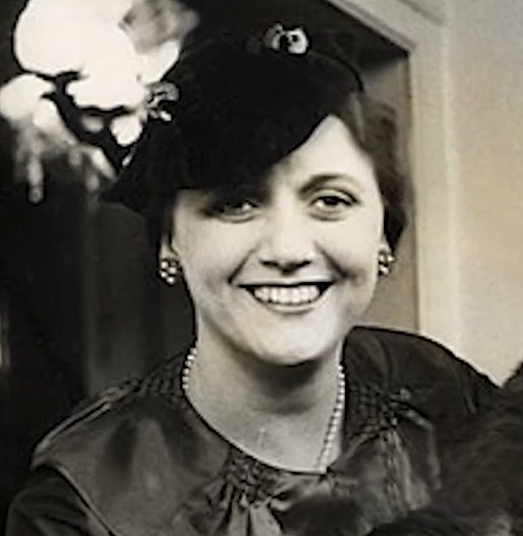
Introduction
In the Second World War, Margery Booth, a Wigan born internationally acclaimed opera singer found herself in the heart of Berlin spying for the Allies. If it weren't for Margery’s name being mentioned in the personal memoirs of World War Two soldier spy John Brown DCM, which came to light after his death in 1964, her story would have gone untold.
A biography based on Brown’s memoirs, entitled ‘In Durance Vile’ was revised and edited by a friend and fellow prisoner of war, New Zealander John Borrie in 1981. Although world famous in her time very little was known of Margery’s private life. Also the very nature of the intelligence services makes detailed information difficult to come by concerning her time in Germany during the Second World War.
Using public records, newspaper reports, and personal memoirs it is now possible to look in more detail at her family background, main characters in her life, singing career, war time exploits and the political and military situation in Europe at the time.
Following further research of the MI5/MI9 files held at the National Archives and also the brilliant and extensive research by Robert Vervaik for his 2024 book 'The Traitor of Colditz' it has been possible to revise and update the 2021 version of this article.
Humble Beginnings
Margery Myers Booth, the only child of Levi Booth and Florence Beatrice Myers Tetley was born 25 January 1906 at 53 Hodges Street, Wigan, a bay windowed terraced property off Park Road to the north of the town centre.
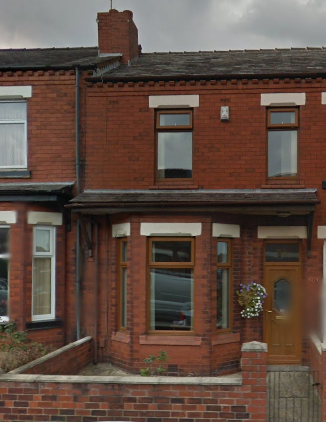
Margery's birth place, 53 Hodges St, Wigan.
Census and parish records show that Margery’s paternal line the Booths were living in Bolton as far back as the late 1700’s. Margery’s grandfather Levi Booth, who was born in 1838, started a business as a wholesale brush manufacturer in 1860, working from 41 Cheapside, off Newport Street in Bolton. He married Yorkshire girl Caroline Roberts Jackson on 6 August 1863 at St. John the Baptist church in Halifax. They were to have seven children, four boys and three girls.
The couple lived in Bolton for a few years, but soon after their son Joseph’s birth in 1867 Levi moved his family and business to Wigan. He is listed in the 1869 Slaters Trade Directory as a brush maker living at 47 Wallgate, opposite the Victoria Hotel, calling his business the ‘Wigan Brush Works’.
The census of 2 April 1871 finds Levi, Caroline, two year old son Richard and two day old baby daughter Sarah living above their shop in Wallgate. At the time of the census their two older children Walter and Joseph were staying with their grandparents near Halifax. It was at 47 Wallgate that Margery’s father, also named Levi was born In 1875. He was destined to become a brush maker like his father.
Levi later moved his premises from number 47 to 18 Wallgate, nearer to Market Place in the centre of town. Here he advertised that he was a brush wholesaler and retailer, also selling baskets, washing lines, cord and twine. A passionate angler himself, he was also a fishing tackle dealer.
His business became a success and by the time of the 1881 census he was employing four workers at his Wallgate workshop. As he became more wealthier he moved his family from over his shop to 29 Upper Dicconson Street. Then later to a larger property, Sicklefield House off Wigan Lane. More moves followed, firstly to Gathurst Lane in Shevington, then to Common Road in Parbold, located in the quiet countryside and away from the bustling Victorian industrial town that was Wigan. In 1906 he advertised in local newspapers that he was having a moving sale and relocating his business premises from Wallgate to 25-27 the Wiend, off Millgate.
Two years later In 1908 Levi was to lose his third eldest son Richard, aged 39 in tragic circumstances. Richard had been working as a commercial traveller for his father but had been in ill health for several years and had been unable to work for the previous month.
On Saturday 20 November Levi received a letter from his son dated the previous day, as a consequence the Leeds & Liverpool Canal near Richard’s home in Clarence Street in Ince was dragged. Richard’s body was found with two handkerchiefs tied around his legs. At the inquest held in front of Coroner Brighouse the jury returned a verdict of ‘Suicide while of unsound mind’.
His two older brothers had chosen to make their own way in life. Walter became a brewery manager in Bolton, whilst Joseph opened a shop in St. Helens selling general goods and brushes manufactured at the Wigan Brush Works. This left just Levi Jnr working in the family business in Wigan.
By 1911 Levi Snr and his wife Caroline, who was now blind had moved from Parbold back into Wigan. They were living above a shop at 25 Mesnes Street opposite the Market Hall, that their divorced daughter Sarah was running. She was selling brushes that her brother Levi Jnr was producing in the Wiend.
Levi Snr died in 1915 in Lytham St. Annes. He had served as a Wigan Town Councillor for over a quarter of a century, being elected to represent the All Saints Ward in 1886. He served on all the council committees and became a Borough Alderman in 1901. As well as sitting on the Borough Magistrate's bench he was also a churchwarden of St. Thomas CE church in Wallgate where for a time he was an overseer of the poor.
For over 30 years Levi was a member of the Independent Order of Oddfellows, a fraternal order, set up to provide care for the needy in a time before the National Health Service and the welfare state. As well he was instrumental in setting up the Wigan & District Amalgamated Anglers Association and was its first President.
Levi Booth Snr was buried in Wigan Cemetery in Lower Ince in a double grave alongside his six month old daughter Sarah who had died in 1874, and his wife Caroline who had predeceased him two years previously. His son Richard, who had tragically drowned in 1908 lies in an adjoining grave.
Maternal Roots
Margery’s mother Florence Tetley came from an old Yorkshire family that can be traced back to the 1680’s. In the 1800’s they were cloth merchants in the Bradford area. Margery’s maternal grandfather James Edward Tetley married a Manchester girl Sarah Elizabeth Myers in 1870. They then moved to Leigh and on the 1871 census are shown living at 71 Lord Street, James’s occupation is shown as a coal proprietor.
James then seems to disappear from the picture and his whereabouts are unclear, the next official record is his death, aged 58 on 11 May 1898 in Queensland, Australia. On the 1881 census Sarah is shown living with her parents Henry and Elizabeth Myers at 1 Florence Street in Hindley near Wigan, with her one year old daughter Florence.
Sarah remarried under her maiden name of Myers on 12 April 1882 at St. James CE church in Poolstock, Wigan. Her new husband, who she was to have three children with was Thomas Mort, a shoemaker and pawnbroker who had a business in Market Street, Hindley.
The census of 1901 shows that 22 year old Florence had left her step family and was once again living with her grandparents Henry and Elizabeth Myers in nearby Castle Hill. She married Levi Booth Jnr four months later on 17 July 1901 at All Saints CE church in Hindley. Five years later, on 31 January 1906 a notice in the births, marriages and deaths section of the Wigan Observer & Advertiser announced the arrival of Margery Myers Booth into the world.
The 1911 census shows five year old Margery and her mother Florence were now living with her great grandparents Henry and Elizabeth Myers at 90 Barnsley Street, a terraced property just round the corner from her birth place in Hodges Street. Margery’s father Levi is shown as being at the Wiend, his business address in Wigan on the night of the census.
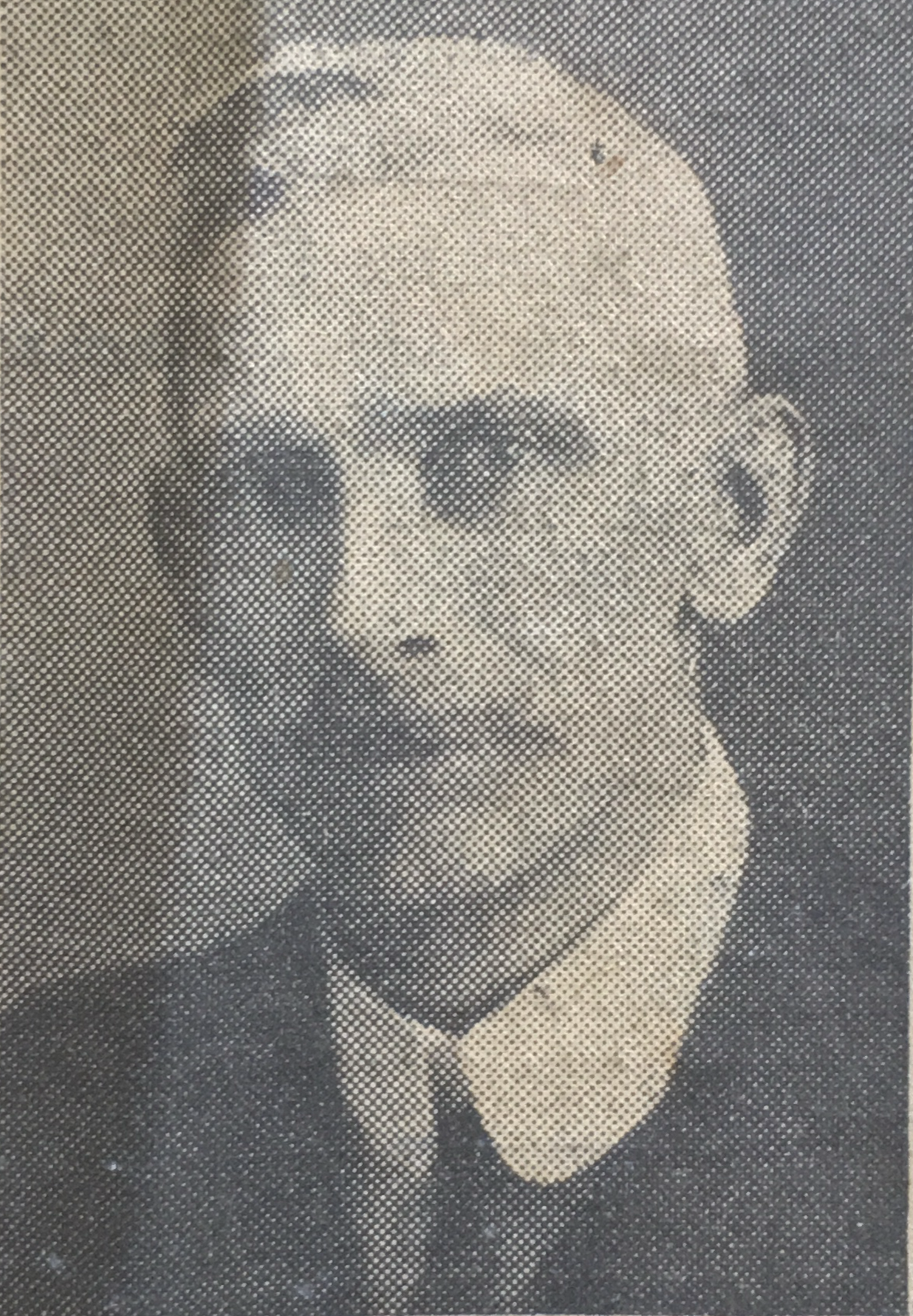
Margery's father, Levi Booth Jnr (1875-1933)
Margery’s name appeared in the newspaper again when the Wigan Observer & District Advertiser dated 11 Jan 1913 showed Margery’s name amongst the list of all the school children invited to Mayor Edward Dickinson’s Juvenile Ball at the Pavilion Theatre in Library Street, Wigan.
New Life in Southport
By 1914 Levi had relocated his family to the Meols Cop district of Southport, moving into a semi-detached house at 87 Clifton Road. Levi commuted daily to his business in Wigan and Margery attended the nearby Norwood Primary school.
The first written record of Margery performing live is an article in the Southport Advertiser, reporting that she sang in an operetta at the age of eight in St. Luke’s church on Good Friday, 10 April 1914. The following year her great grandparents Henry and Elizabeth Myers moved from Wigan to live with them in retirement at Clifton Road.
Alas all was not well in her parents’ marriage and in 1918 they separated. Levi petitioned for divorce from Florence, on the grounds of her misconduct with a man named William Fairhurst at the family home in Clifton Road. Fairhurst was said to keep an off licenced house in Woodhouse Lane, Wigan. Levi told Mr. Justice Shearman that his wife had taken to drink and they then had entered into a deed of separation. A Decree Nisi was granted in 1919.
Margery’s parents both remarried in 1920. Her father married Ada Sidebotham in July at Hope Street Congregational Chapel in Wigan town centre. Ada had been living above his brush shop in the Wiend for a number of years. Her brother was Ezra Sidebotham, a printer of long standing in Wigan, he also had premises in the Wiend.
Her mother Florence married William Fairhurst, twenty years her senior at Ormskirk Register Office in September of that year. William, whose father was a publican had been in the brewery trade all his life and described on various censuses as barman, brewer, mineral water bottler, and publican. The 1921 census finds Margery living in Clifton Road with her mother and step father, whose occupation is shown as commission agent for Burtonwood Brewery of Newton Le Willows, near Warrington.
Margery’s talent as a singer had been recognised at an early age and it was after her mother’s second marriage that she was given the chance of professional training as an opera singer. She had inherited her singing talent from her father who had a fine treble voice. In his youth he had been leading soloist in the Wigan Parish church choir and was a member of Wigan Operatic Society.
At the age of 14 she started on the long road to stardom which would require dedication and years of hard work. Opera singers have to be extraordinarily disciplined, mastering the art of acting and stage presence. Being bilingual and the ability to sing in several languages is essential, therefore the study of foreign languages at music school is mandatory.
Margery firstly began a two year course of singing lessons in Bolton under the tuition of Welshman Richard Evans, an ex-miner from Ruabon near Wrexham. There then followed a move down to London for six months private tuition with professional singer Aileen D'Orme in Knightsbridge.
She then attended the prestigious Guildhall School of Music and Drama for a further two years training to perfect her contralto voice. In 1924 she won the Mercer Scholarship of 50 Guineas, which she repeated the following year, also gaining the Liza Lehman prize of ten Guineas.
It was whilst at the Guildhall School that she met and struck up a friendship with a young German student who was staying in the same digs. His name was Egon Strohm and he was in London studying English Language. They both went their separate ways to pursue their careers but were destined to meet again.
Journey to Berlin and Fame
On completion of her training Margery found it difficult to secure engagements and after an illness travelled to Switzerland in order to recuperate. It was here that she was advised to go to Berlin to pursue her dream of being a professional opera singer.
In 1928 she made a successful audition with the Berlin Staatsoper Unter den Linden (Berlin State Opera House). The iconic building, close to the Reichstag and Brandenburg Gate, and built by Frederick the Great in 1741 had just reopened after a two year refurbishment.
After a further six months training under the tutelage of the famous French soprano, Lola Artot de Padilla she signed a one year contract and made her first appearance in Berlin that year, a minor part in the opera La Tosca. Margery soon became a favourite with Berlin audiences. In 1930 she had a lead part in the new German opera Der Fremde Erde’, an honour rarely accorded to foreigners.
On 17 Aug 1932 the Lancashire Evening Post published a short article with the headline banner ‘A Southport Girl Who Sings in Berlin’, Margery is quoted as saying: 'I love coming back to Southport for a holiday, but I love Germany so much now that I would not like to leave it. If you have talent the German people will back you up, second rate is not sufficient, nor will they find excuse for an artist who is out of condition. The Germans don’t think the English have any talent and will only believe you are English when you have thoroughly convinced them'.
Little did Margery know that during the following year of 1933 events would unfold that would lead to Germany becoming a dictatorship, the destruction of Europe in the Second World War and the eventual end of her singing career. In a very eventful year, her mentor Lola de Padilla, whom she had served her apprenticeship under, died in Berlin on 12 April.
A few weeks later on 9 May her mother Florence died of cancer, aged 54. At the time she was living at 24 Lethbridge Road, the property her and William had moved to a few years earlier. She was buried in Duke Street Cemetery in Southport alongside her grandparents Henry and Elizabeth Myers who had died during the Great war in 1915 and 1918 respectively. Margery was the sole beneficiary of her mother's will which included the two properties of Lethbridge Road which her step father continued to live in and their old home in Clifton Road which was rented out for extra income.
Adolf Hitler became Chancellor of Germany on 30 January 1933. It was through his love of classical music that Hitler’s and Margery’s paths were to cross a few months later. After five years at the Berlin State Opera she was now a principal singer and the only English prima donna in Berlin, singing in German, French, Italian and Spanish. That year she was invited to sing at the Bayreuth Festival in northern Bavaria, and was chosen to carry the Holy Grail in the opera Parsifal which opened on 22 July.
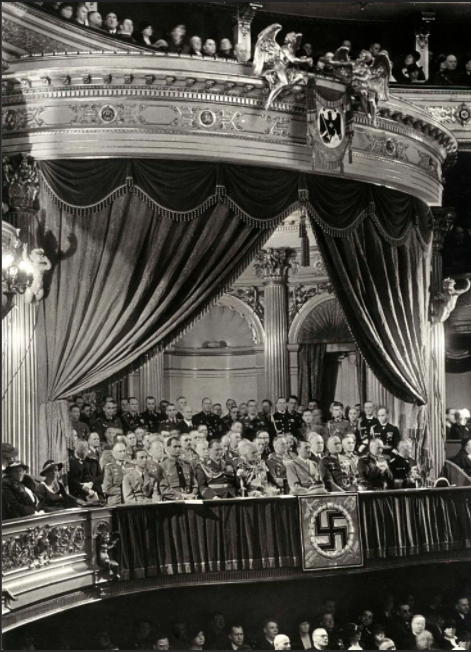
Adolf Hitler and his top Nazi officials attending the Berlin Opera House in 1936
Hitler had an almost fanatical devotion to the work of the 19th-century German composer Richard Wagner, which to him represented everything that was good about culture in Nazi Germany. His attendance at the Bayreuth Festival was very well publicised by Joseph Goebbels, the Minister for Public Enlightenment and Propaganda.
Margery revealed in an interview with the Lancashire Daily Post in December 1933 that she had met Hitler and also Crown Prince Wilhelm of Prussia and his wife Cecilie, the Duchess of Mecklenburg-Schwerin. She told the reporter: 'I had dinner with Herr Hitler and the Crown Prince and his wife. I received a beautiful bouquet of red roses and the people I met were all very charming. The ex-Crown Princess introduced me to her friends as ‘her baby’ and has promised to promote a concert at Potsdam at which I shall sing'.
The Crown Prince or ‘Little Willie’ as he was known as, was a passionate devotee of opera. He admired Margery’s singing and they were to become firm friends, this friendship was to prove invaluable a decade later.
During a later interview with the Liverpool Echo in 1936 she recounts that after one of her performances she was presented to Adolf Hitler and said of him: 'He was perfectly charming and they talked about art and music'. Margery was to become one of Hitlers favourite singers.
Held annually in July since 1876 the Bayreuth Festival is a month long performance of operas presented by the Wagner family. Performances take place in the Bayreuth Festpielhaus, a specially designed theatre which Wagner personally supervised the design and construction of.
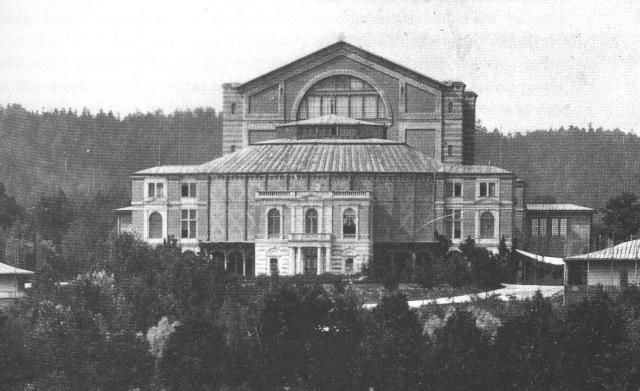
Wagner's Festspielhaus at Bayreuth, Germany
The overall Director was English born Winifred Marjorie (nee Williams) Wagner. Originally from Hastings in Sussex and orphaned at an early age, she was sent to live with relatives in Germany. She married 46 year old Siegfried, the bisexual son of Richard Wagner at the age of eighteen in 1915.
She took over the running of the festival after her husband's death in 1930 until the end of World War Two in 1945. A personal friend and supporter of Adolf Hitler, she maintained a regular correspondence with him. They had met in 1923, the year that Hitler was jailed for his part in the Munich Beer Hall Putsch.
She sent him food parcels and stationery in Landsberg Prison, on which it is thought he wrote his autobiography Mein Kampf. Her antisemitic views led to her joining the Nazi Party in 1926 and in the late 1930’s she served as Hitler’s personal translator during treaty negotiations with Britain.
Whilst Margery was performing at Bayreuth her father died on 12 August 1933 aged 58. He was buried three days later in Wigan Cemetery, Lower Ince, alongside his parents and sister Martha Annie who had died aged five and half months in 1874. Margery’s parents had both remarried in 1920 and by a quirk of fate she was to lose them both in the same year.
In late 1933 Margery was hospitalised in Berlin, after an operation she started a period of recuperation which included a visit back to Southport for a short holiday. The following year she was invited back to Bayreuth, this time with the solo role of a flower maiden in the opera Parsifal and of Flosshilde, and a Rhine maiden in the fourth part of the opera Götterdämmerung. In the lavish production 1,500 costumes were used and 800 people employed, including 137 musicians.
At the time no one was aware that Margery was unwell again and had sung at least twenty times at Bayreuth in agonising pain, this led to her undergoing surgery again. She wrote to her step father William from her hospital bed in Erlangen, just north of Nuremberg in Bavaria, telling him she had had an operation for an internal complaint.
Hitler expressed concern and gave orders that she was to be well looked after and Goering and Goebbels sent messages of sympathy. The Queen of Denmark also sent good wishes and invited her to her country to sing. It was after a two month recovery that Margery was fit enough to start singing again.
Recognition at Home
Although famous in Germany and on the continent where she sang in the capitals of Europe, Margery was up to now virtually unknown at home. After her success at Bayreuth this was about to change. In 1935 she was invited to sing at the Promenade Concerts, (more commonly known as the Proms), with the BBC Symphony Orchestra at the Queens Hall in London. (the building was destroyed in the Blitz in 1941 and the Proms then moved to its new home at the Albert Hall).
The Proms Concerts were broadcast on the radio and soon Margery’s voice was to be heard in every home in the land. After years of hard work she was finally getting the recognition she deserved.
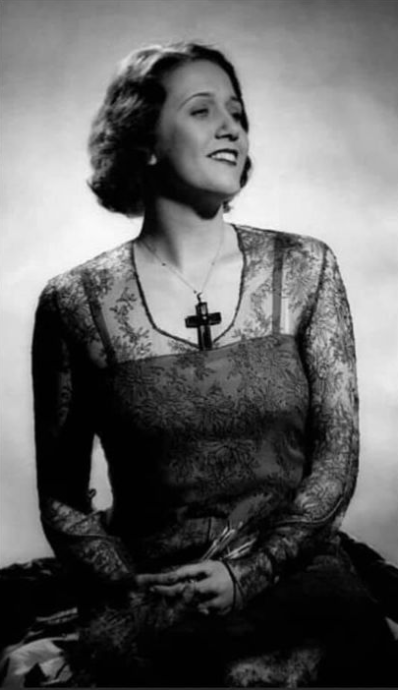
Margery at the height of her fame
Following her mother’s death from cancer, Margery became a keen supporter of cancer charities and research. Whilst based in London singing with the BBC Orchestra she took the opportunity to sing in a benefit concert at the Palace Theatre in the West End. This was in aid of the Holt Radium Institute which had amalgamated with Christies Cancer Hospital in Manchester two years previously. On 4 October 1935 she sang professionally for the first time outside of London when she performed at a concert at the Queens Hall, Market Street in her home town of Wigan.
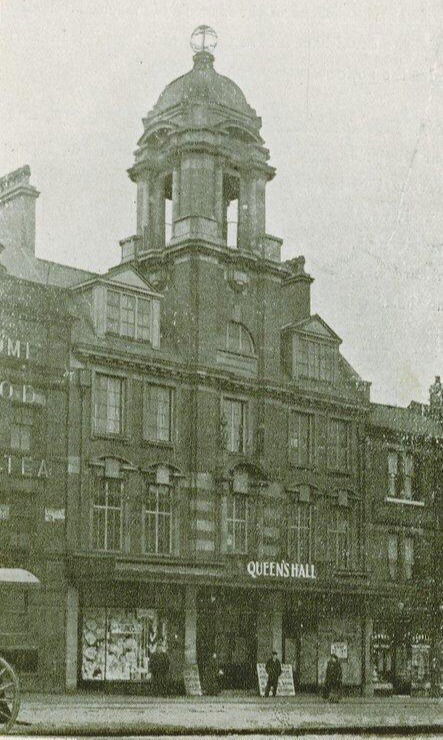
Queens Hall, Market St, Wigan
Now at the height of her fame, 1936 was a busy year for Margery. Her new contract with the Berlin Opera stipulated that she spend seven months of the year in Berlin, singing on 60 nights during that time. During the other five months she was allowed to undertake tours. She finally fulfilled her greatest ambition of singing at the Royal Opera House in Covent Garden, London on 27 April when she played the role of Magdalene in Wagner’s opera Die Meistersinger. That year she was to create a record 23 appearances in the Covent Garden opera season.
It was after her successful debut in London that she announced her engagement to Egon Strohm, the German who she had first met as a student in London eleven years previously. She had hoped for a quiet ceremony in her adopted town of Southport four months later. However the news of her impending marriage leaked out. Not wanting to turn her special day into a media circus she cancelled the wedding indefinitely on the pretence that she was suffering from influenza.
She then discreetly rearranged for the wedding to go ahead the next day with only herself, Egon and the Vicar in the know, with the guests to be only informed at the last possible moment. Such was the secrecy that the officiating minister the Revd Canon Walter Morris, the Rural Dean of North Meols, was only given one hour's notice of the time of the ceremony. He married Margery and Egon by special licence at All Saints CE church in Rawlinson Road the next day, Wednesday 26 August.
Apart from Margery, Egon and the vicar, the only other people at the ceremony were her stepfather William Fairhurst who gave her away. Her cousin Marjorie Harrison who lived in Golborne and a neighbour from Lethbridge Road, fifty six year old Hubert Hunt, who was drafted in at the last minute to be the second witness. The best man, Thomas Forshaw, the Managing Director of Burtonwood Breweries at Newton Le Willows, near Warrington, the firm that her step father worked for, was unable to make it in time and missed the ceremony completely, only arriving in time for the reception at Margery’s family home.
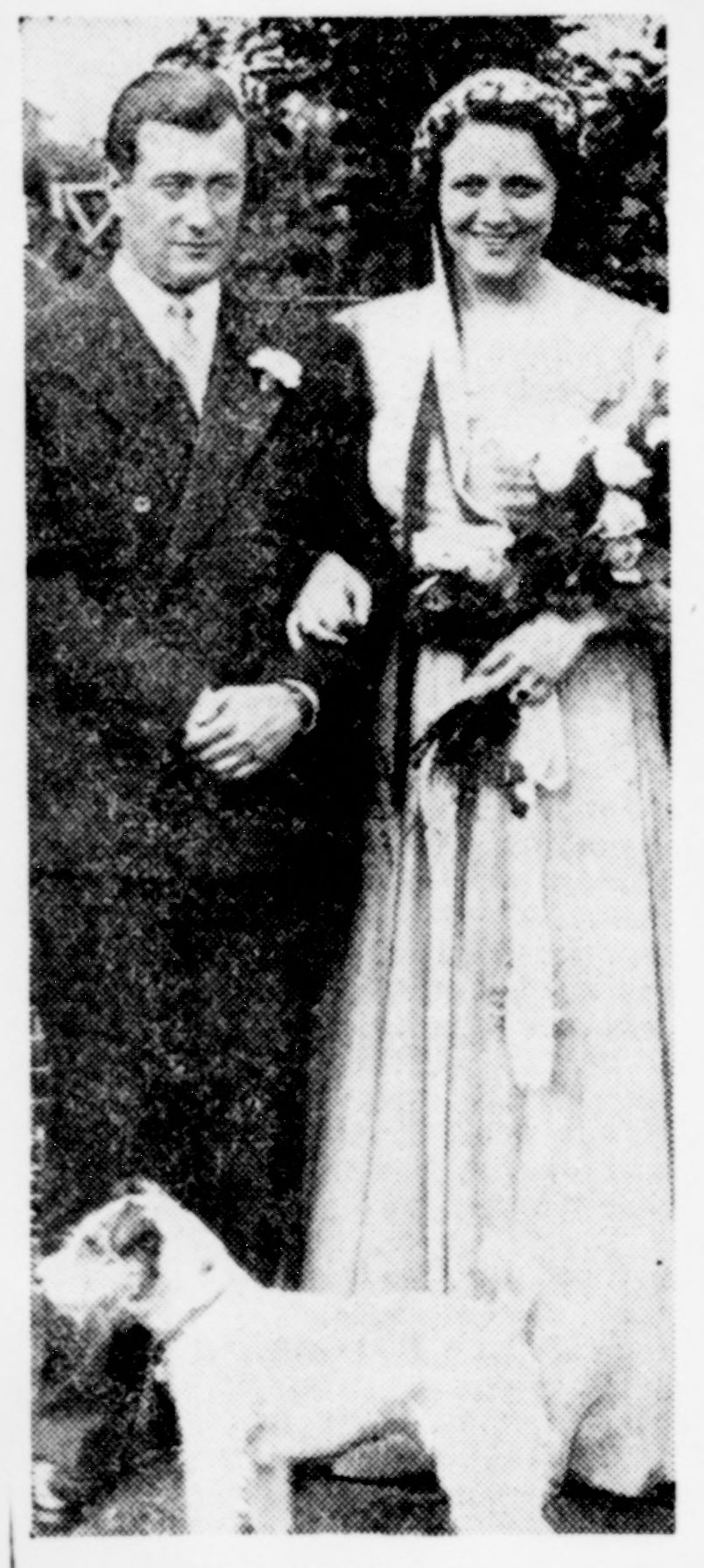
Margery and Egon on their wedding day in 1936 with Terry her pet dog
Margery and Egon spent their honeymoon in Scotland before returning to Germany. In an interview with the Airdrie & Coatbridge Advertiser she is quoted as saying; 'When in England, nothing delights me more than go north and sing among my own people'.
It was reported that the following month she was to sail from Hamburg to America where she was to take part in the film adaptation of Aida, the opera by Guiseppe Verdi. On completion of which she was to travel to Cairo on a singing engagement before returning to Germany. (It is not known if she did travel to America as the film was not made. It was eventually produced in 1953 with Sophia Loren in the starring role. Her voice over was sung by Italian opera singer Renata Tebaldi).
German Husband
Margery’s new husband Dr. Egon Strohm was born 24 Oct 1904 in Trossingen in the State of Baden-Wurttemberg, the picturesque Black Forest region of south west Germany. His father Christian, was a member of a prominent brewing family and lived in a villa he had built in 1925 in Schwenningen, a town close by Trossingen where Egon was born.
The brewery in Trossingen was founded in the late 19th century and by 1904 it was known as Zum Baeren and owned by Johannes Strohm. It was renamed the Baerenbrauerei in 1920. The family operated a second brewery in the nearby town of Schwenningen with the owners being Gebrueder Strohm (Strohm Brothers). The brewery used a bear as its symbol and this became as famous as the animals on the State crest, a lion, stag and griffon.
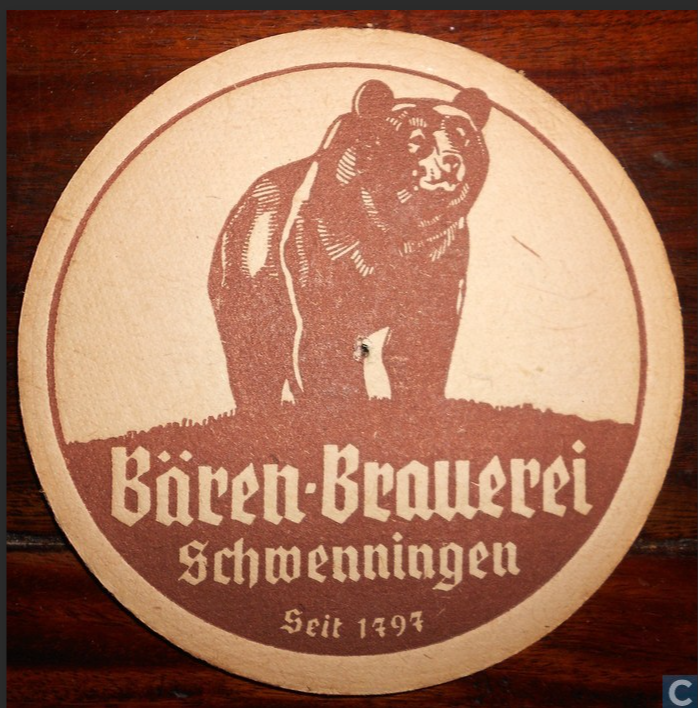
A beer mat from the famous Bear Brewery in Schwenningen, Bavaria.
Egon didn’t enter into the family business but instead pursued an academic career. After University he moved to Berlin where on 14 August 1928 he married Elisabeth Martha Czaika. The marriage banns show he was a 23 old student living at Prinzregentenstrasse 83, Wilmersdorf in the south west suburbs of the city. Elizabeth, also 23, had been born in Lodz, Poland.
The marriage was not to last very long however and was dissolved in January 1930. Elizabeth reverted back to her maiden name, marrying for a second time to Raimond Fredrich Anton Spitzer on 4 April 1931.
During the 1930’s Egon worked as a journalist and radio reporter, whilst also studying for his Doctorate degree at Heidelberg University. In 1935 he qualified as a Doctor of Law and Economics after writing a dissertation for his PhD. entitled 'The British Empire as an Economic Entity'.
After Margery’s arrival in Berlin, which coincided with Egon’s first marriage, the pair eventually renewed their friendship from their student days in London and this led to a romance and marriage in England.
With her new contract giving her more freedom, Margery spent her time touring and commuting between Germany, England and America. She made a flying visit to Lancashire on 31 January 1937 to sing in a Manchester concert in aid of Christies Cancer Hospital and to visit Southport.
Egon met up with her in Southport after a trip to New York, arriving in Southampton on 16 March on SS Westernland, a German owned transatlantic liner, sailing the Antwerp, New York, Southampton route.
On Saturday 15 May she sang again at the Queens Hall in Wigan, fulfilling a promise she had made two years previously that she would return to her home town. The concert was to celebrate the Coronation of King George VI that had taken place three days beforehand. All benefits went towards Mayor Peter Winstanley's Royal Albert Edward Infirmary fund.
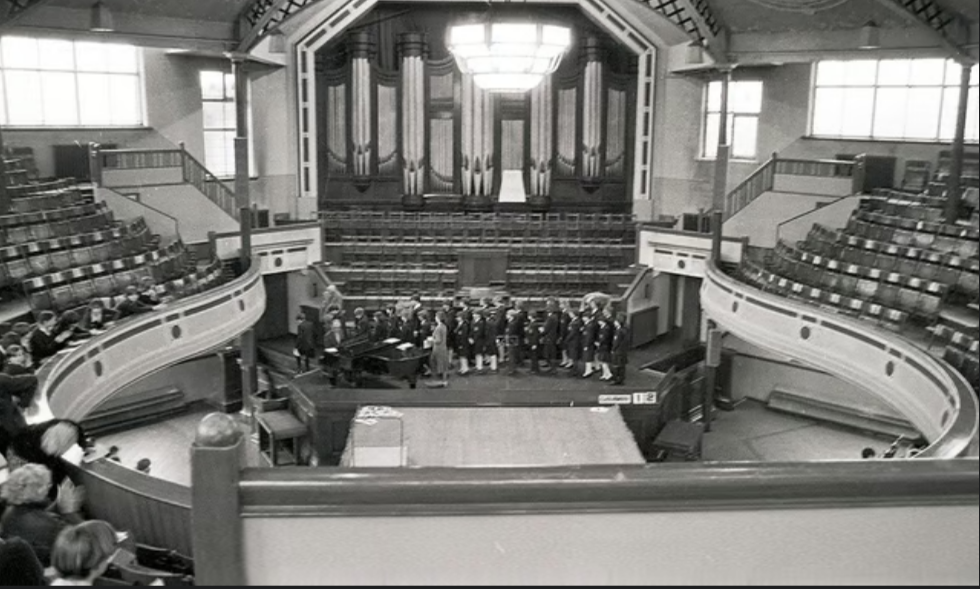
Interior of the Queens Hall, Market Street, Wigan
In July she was back in Southport for six weeks to stay with her step father in Lethbridge Road. Events led her to put all her engagements to one side, including a planned trip to the Isle of Man. Instead she spent her time frantically searching for her lost dog, a Terrier named Terry who had been missing for ten days. She put notices in shop windows, appealed in the newspapers and visited all the police stations in the area.
At Ormskirk police station they told her they had found a dog answering Terry’s description and had sent it to Walton dogs home. At Walton she found it had been sold to a Bootle man. At Bootle the buyer said he sold it to a man in the same street. The search ended in the home of the second buyer where Margery was able to buy Terry back.
War Clouds Looming
By 1938 the situation in Europe was deteriorating fast. Germany was now a fascist state with Hitler as Führer having full control of all political and military matters. The country had secretly been rearming for a number of years and war in Europe was now inevitable.
On 12 March German troops marched unopposed into Austria. In what's known as the ‘Anschluss’, Austria was annexed into Greater Germany. Hitler next set his eyes on the Sudetenland, the border regions of Czechoslovakia. On the pretext that German speaking Czechs were being victimised he demanded the region be handed to Germany by 1 October.
In August 1938 Egon started working for Reichs-Rundfunk-Gesellschaft (RRG), the Nazi German national radio network, at its main Berlin station. He was a commentator using the alias 'Scrutator' for the South East Asia Zone, and also an English language commentator on the Short Wave station. All broadcasting was under the direct control of the Ministry of Public Enlightenment and Propaganda led by Joseph Goebbels.
The leaders of Britain, France, Germany and Italy met in Munich on 29/30 September 1938 and following a policy of appeasement by England and France the Czech President Edvard Benes was persuaded to submit to Hitlers demands. The next day the Sudetenland was annexed to Germany.
British Prime Minister Neville Chamberlain returned to England waving a worthless piece of paper declaring 'Peace in our time". Six months later however on 14 March 1939 Germany invaded the Czech lands and proclaimed the State of Slovakia, moving one step closer to all-out war in Europe.
Three weeks later on 7 April Egon departed on a trip to America, sailing on SS Bremen from the northern port of Bremen for the week long voyage to New York. The ship’s passenger list shows that Egon was travelling second class with three other radio reporters, two German and an Argentinian.
Their passages were paid for by the German Government. In what was probably a diplomatic trade mission, other passengers sailing courtesy of the government were businessmen and diplomats from Germany, Japan and other various countries.
The War Years
The United Kingdom declared war on Germany on 3 September 1939, two days after the German invasion of Poland. Margery, by now a naturalised German citizen living in Berlin with a German husband was in the unenviable position of seeing the country of her birth at war with that of her husband’s and her adopted country of residence.
At the time Margery and Egon’s home was at Wieland Strasse 10, in the south west of the city in the Charlottenburg district, near Tempelhof Airport. For the first two years of the war life for the citizens of Germany more or less carried on as normal, with the Germans basking in their military victories. Margery continued singing at the Berlin Opera House and at the Bayreuth Festival.
Egon was now an established commentator at the Reichssender (Berlin National Radio) and was involved in the same English language output team as Lord Haw Haw and other traitors. He was right at the heart of the Nazi propaganda machine trying to influence British public opinion and morale
In 1941 the South East Asia Zone was absorbed into the Empire Zone embracing the entire English speaking world outside Great Britain and the USA. It's programmes were broadcast in English and Dutch. Egon was appointed section head with a team of twenty full time and ten free lance contributors.
It wasn’t until 25 August 1941 that Berlin suffered its first air raid when Tempelhof Airport was targeted by the RAF. After that, air raid precaution instructions were printed in the programmes at the Berlin Opera House.
The following year in September 1942 Egon was dismissed from his job at the RRG following an irregularity involving a trip accompanying Margery to an engagement in Budapest. He was later re-instated and allowed to work for the Zone as Chief Commentator.
The Berlin Opera House was badly damaged in a blaze caused by incendiary bombs during a raid by the RAF in October 1943, targeting the cultural area in the city centre. The raid was ordered by Churchill in retaliation to an attack by the Luftwaffe on Belgrade, the capital of Yugoslavia a few days previously.
The Opera House managed to open again for performances but was finally shut on the orders of Joseph Goebbels the next year. The last performance before closure that Margery would have been involved in was Mozart’s Le nozze di Figaro (The Marriage of Figaro) on 31 August 1944.
During the war the Bayreuth Festival was turned over to the Nazi Party, which continued to sponsor operas for wounded soldiers returning from the front. These soldiers, as guests of the Fuhrer, were forced to attend lectures on Wagner before the performances. This arrangement continued up to 1944.
The town of Bayreuth was bombed by the United States Air Force in the latter stages of the war and two thirds of the town was destroyed. The home of the Wagner family 'Wahnfried' was damaged but the Opera House remained unscathed.
Whilst Margery was living in the heart of Nazi Germany her adopted home town of Southport was on the receiving end of visits from the Luftwaffe. The little seaside town had been considered a safe haven and was an evacuation centre with 15,000 child evacuees, not only from the Liverpool area but from afar as London.
The main target in the north west of England was of course Liverpool and the docks at Bootle and Birkenhead. Unfortunately Southport was on the flight path to and from Liverpool along the River Mersey. The town was only 13 miles from Bootle, a few minutes flying time. Crosby, Ainsdale and Birkdale were also on the receiving end of unused bombs jettisoned by aircraft on their way back to their bases.
Southport was to suffer eleven air raids in total over a period of nine months, the first on 4 September 1940. On the eighth raid on 8 April 1941 high explosive and incendiary bombs were dropped in the area quite close to Margery’s home in Lethbridge Road.
The vicarage of All Saints church where Margery and Egon had been married was damaged by a blast in the neighbourhood and the Vicar Canon Morris and his wife were slightly injured. In total during the raids on Southport 17 people were killed and 76 injured.
Margery's step father William Fairhurst died on 13 January 1943. He had last seen his step daughter in August 1939, just prior to the outbreak of war and last heard her voice in a German broadcast on an all Irish programme for American viewers. He was buried in a lone grave in Duke Street Cemetery in Southport. There have been suggestions that he disowned Margery completely because of her Nazi connections and the loss of life and damage caused by the bombing raids on Southport.
Probate records confirm that William did indeed cut her out of his will which was left to relatives in Wigan, and also a couple who shared his property with him in Lethbridge Road. In hindsight this was the only practical solution as it would have been virtually impossible for his executors to enact his wishes if Margery had been a beneficiary living in war time Germany.
Soldier Spy
Margery’s tale is inextricably linked to that of John Brown, the soldier spy, and his story has to be told in tandem with hers. John Henry Owen Brown was born in Battersea, London in 1908 to James Brown, a printer compositor by trade and Priscilla Francis (nee Martin) Brown.
A Cambridge graduate, John was employed as an accounts manager at Trumans Brewery in Brick Lane, East London. In early 1939 the thirty year old, nicknamed 'Busty Brown was married for a second time to Nancy Mason. In February of that year he joined a Territorial Army unit, 226 Battery, 57th Light Ant-Aircraft Regiment, Royal Artillery, whose headquarters were at Wimbledon.
Brown gained rapid promotion and by November 1939 held the rank of Staff Sergeant with the appointment of Battery Quartermaster Sergeant (BQMS). He was selected to attend a special Senior Non Commissioned Officer‘s course of instruction on how to gain intelligence once captured and in enemy hands.
The NCO's were encouraged to observe and remember details about enemy forces, such as troop strengths, morale, equipment, and tactics. Crucially they were taught a code that could be used in seemingly innocent letters home. Known as the 'HK Code', MI9 had developed it with the help of a Foreign Office expert called Hooker.
Brown's unit went over to France as part of the British Expeditionary Force (BEF) on 9 April 1940. He was captured on 29 May 1940 near Caestre, approximately 20 miles south east of Dunkirk, as the BEF withdrew to the channel ports as part of an evacuation plan. In a column of 3,000 prisoners he then trekked over 200 miles through France, Belgium and Luxembourg to Trier in Germany.
Here he was put in an overcrowded cattle wagon and transported 600 miles to Stalag VIII-B at Lamsdorf in Upper Silesia (now Lambinowce in modern day Poland). One of the largest POW Camp complexes in Europe, Lamsdorf was also the largest camp for British and Commonwealth troops, with about 48,000 prisoners passing through it's gates during the war.
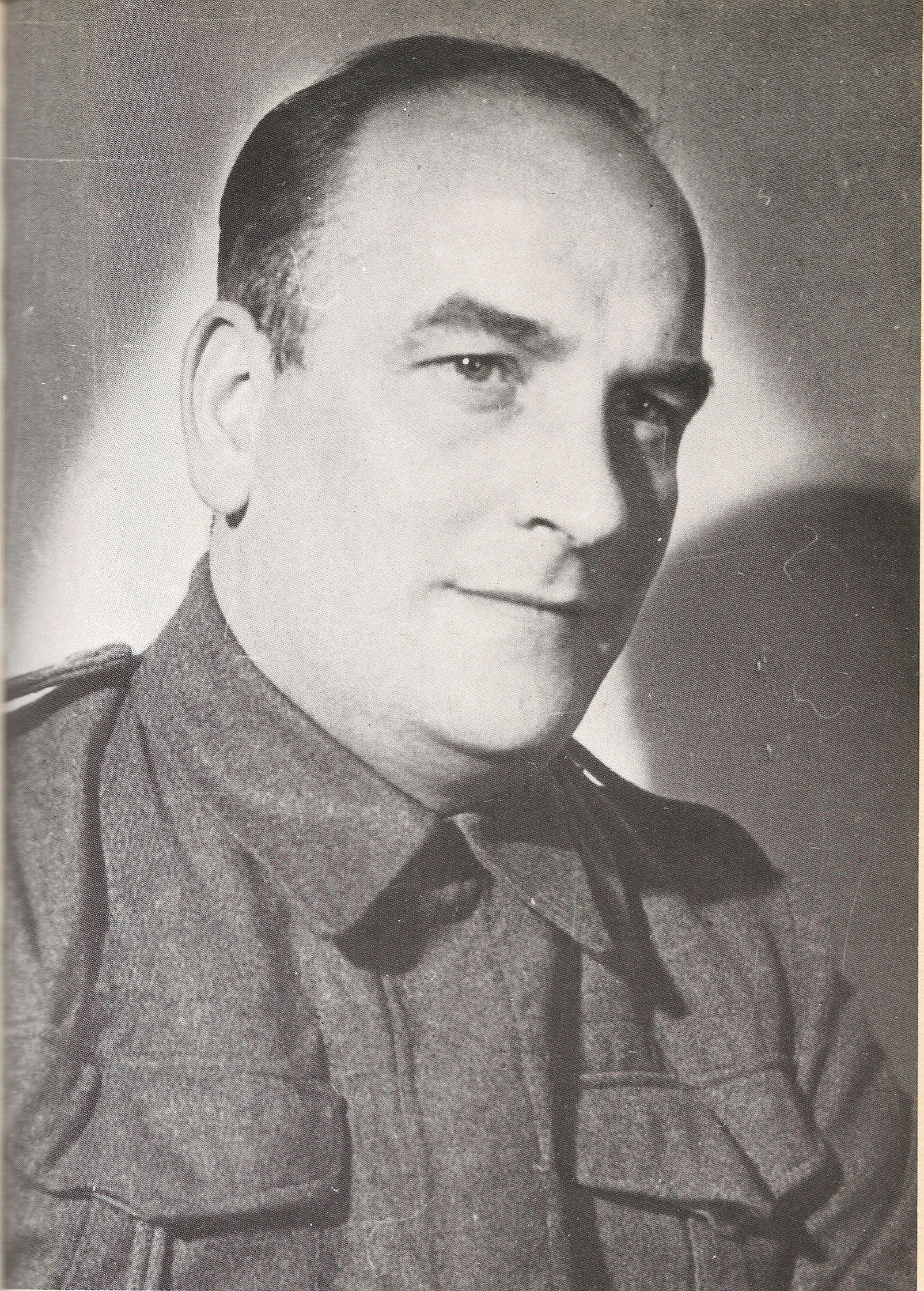
BQMS John Brown, Royal Artillery at Stalag VIII-B , Lamsdorf
Not wanting to just sit the war out in a prisoner of war camp Brown decided that he could help the war effort by becoming a self-made spy. At the start of their captivity prisoners had to use POW postcards to send brief messages home, so he got his first letter home by bribing a Dutch civilian with extra rations in order to pass it to a Swedish sea captain sailing from the North German port of Stettin. The letter was intercepted by the MI9 escape and evasion network, who then got the Secret Intelligence Service, better known as MI6, to write to John on the pretence of being a friend or relative. Brown’s letters home were then intercepted and read by MI6 before being forwarded on to his wife Nancy.
At Lamsdorf he reasoned that if he were to gain any information useful to the Allies he would have to get away from the huge Lamsdorf camp which housed 5,000 prisoners. As a senior rank he was not obliged to work for the Germans, but he nevertheless volunteered to go to an Arbeitslager (work camp). He was transferred to Arbeits Kommando E/3 at Blechhammer (now Blachownia Śląska), one of seven POW camps in the area, some 40 miles to the east of Lamsdorf.
At Blechhammer, military prisoners of war of several nations, as well as thousands of Jewish slave labourers, who were housed at a nearby sub camp of Auschwitz-Birkenau Concentration Camp, worked on two huge construction sites two miles apart. These would eventually become chemical plants using bituminous coal to produce synthetic oil. The prisoners at E/3 worked on Blechhammer North, their back breaking work consisted of clearing a forest site of tree stumps and stones and making access roads.
Brown decided early on that the best way to gain intelligence was to appear sympathetic to the German cause and get them to trust him. Striking up a good relationship with the Commandant of Blechhammer, Prince Waldemar Zu Hohenlohe-Öhringen was his first task.
Next he wrote an article entitled 'A Year Passes' in the POW weekly propaganda newspaper 'The Camp', it was published in Berlin on 7 September 1941 and distributed all over Germany. In it he praised the German authorities for providing all the necessities needed for prison camp life.
He knew that the Germans would notice his comments in the article and link it with the fact that before the war he had been in the British Union of Fascists, for which they had a list of members. At the same time he also knew it would make his fellow prisoners distrust him and even loathe him as a Nazi sympathiser.
Brown’s plan worked, in February 1942 he was transferred to Work Party 806 at Stalag III-D in south west Berlin for assessment by the Germans. One day he was taken to a house in Steglitz that contained men of many nationalities. it was being used as a holding centre for special prisoners, and was the prototype of a special camp the Germans were planning. He shared a room with Lieutenant Ralph Holroyd, an Australian whose German born mother was still living in Germany. Holroyd refused to co-operate with the Germans and was eventually sent back to an Oflag (officers prison camp).
At the house he was interviewed by none other than William Joyce, the traitor who broadcast anti British propaganda on Berlin Radio. Brown had actually met Joyce before the war in the Fascist HQ Club in Kensington Road, Chelsea but did not disclose this to Joyce who did not recognise him.
William Brooke Joyce was born 24 April 1906 in Brooklyn, New York. He was the son of an Irish Catholic father from County Mayo and an English mother who had been born in Oldham, Lancashire. When William was three the family returned to live in Salthill, County Galway in Ireland.
On 22 Oct 1924, whilst stewarding a Tory meeting in London he was attacked by a communist who slashed him with a razor on his right cheek, leaving a deep prominent scar from his ear to the corner of his mouth. In 1932 Joyce joined the British Union of Fascists under Sir Oswald Mosley, known for his talent for public speaking he swiftly became a leading speaker. Appalled however, by the violence of Moseley’s Blackshirts he left and started up a breakaway organisation, the National Socialist League.
In late August 1939, shortly before war was declared, Joyce and his wife fled to Germany. Joyce had been tipped off that the British authorities intended to detain him under Defence Regulation 18B. This regulation allowed internment without trial of people suspected of being actively opposed to the ongoing war with Germany.
Allying himself to the Nazi cause, he became a naturalised German citizen in 1940. Working for the Reichsrundfunk (German State Radio) in Berlin he broadcast anti British propaganda in an effort to undermine the nation's morale, urging Britain to surrender.He started his broadcasts with the introduction 'Germany calling... Germany calling'. Millions listened to him on their radios but he soon became an object of ridicule leading to him being labelled 'Lord Haw Haw' because of his affected upper class English accent. Owing to increased bombing raids on Berlin, Joyce broadcast from several locations including Luxembourg, Bremen and Hamburg.
His wife Margaret (nee White), born in Carlisle in 1908 was herself an ardent fascist. An accomplished speaker but less well known, she also had her own propaganda radio program. She was nicknamed 'Lady Haw Haw'.
Over the next few weeks Brown was allowed to go on walks round the city with a guard and he used the opportunity to do reconnaissance on potential targets and even managed to get close to Tempelhof Airport. However, William Joyce had taken a dislike to Brown and had given him a negative report. Major Heimpel of the Abwehr also did not trust him, so he was sent back to Stalag VIII-B at Lamsdorf. It wasn’t until August 1942 that he was able to get back to Arbeitskommando E/3 at Blechhammer.
In his letters home he passed on the locations of anti-aircraft defences, barracks and camouflaged sites in Berlin and the purpose of the construction work going on at Blechhammer South, namely the Heydebreck oil refinery. Known to Allied bomber crews as 'Black Hammer' the site was first bombed by the 15th US Army Air Force on 30 October 1943. Despite several bombing raids, production of synthetic oil eventually began at Blechhammer on 1 April 1944.
In March 1943 a message from London told Brown to try and arrange a transfer back to Berlin and obtain details of Englishmen broadcasting propaganda for Germany. After a carefully orchestrated row with the senior British NCO’s at Blechhammer he persuaded the Commandant to transfer him back to Stalag III-D in Berlin Lichterfelde, arriving on 12 June 1943.
Two new further sub-camps were created in May to June 1943, coinciding with Brown’s transfer to Berlin. Stalag III-D/999, in Kaun Strasse located in the Zehlendorf West district was to house officers. Stalag III-D/517 at Genshagen in the Ludwigsfelde district in the south west of the city was earmarked for other ranks.
Prisoners of war were selected by the Germans at random to go to these special camps for a month's rest. With better facilities they soon became known as 'holiday camps' by the POW's, a chance for a while to get away from the poor rations and hard work in the coal mines, quarries and factories and on the railways.
However the Germans planned to use these special detachments to separate potential collaborators from other British POWs. They particularly sought out former members and sympathizers of the British Union of Fascists.
Brown was appointed by Dr. Arnold Hillen Zeigfeld, the head of the English Department of the German Foreign Office, and the architect of the holiday camps, to be senior British NCO in charge of administration at Special Detachment 517 based at Genshagen. A former Hitler Youth Camp, it had no watch towers and although it was surrounded by barbed wire, hedges and trees planted on the inside perimeter gave the illusion of an open camp.
The camp which could house a maximum of 270 men, came under the responsibility of the Foreign Ministry and Joseph Goebbels's Ministry of Propaganda. Camp security was run by the Abwehr, the German Military Intelligence, responsible for espionage, counter intelligence and sabotage. The guards, all English speakers so that they could eavesdrop on the POW's just carried holstered pistols instead of rifles, in an attempt to look less threatening.
The first batch of 200 holidaymakers arrived in April. Among these were his hand-picked staff of four who he could trust to help him run the camp, including his right hand man Jimmy Newcombe who he had requested to be transferred from Blechhammer.
As Vertrauensmann (man of confidence) he quickly made himself at home. He organised a black market to procure luxuries for the camp inmates and smuggled a radio receiver in so that he was aware of the course of the war. Brown ensured that they were looked after and got a well-earned rest away from normal POW camp life and work details
By a stroke of luck he discovered the purpose of the holiday camps. A young soldier at the camp, who Brown knew as Oscar England (this was an alias, his real name was Carl Britten) became seriously ill and the Gernan doctor didn't expect him to live. He confided in Brown that the reason to invite the prisoners to a rest camp was to recruit POW’s into the Britisches Freikorps (British Free Corps or BFC), a small unit of the Waffen SS raised to fight in the east against Bolshevism.. The Germans had been in discussions with Britten in an effort to persuade him to join the BFC. Brown then made it his mission to ensure that any attempts to form the British Free Corps would fail.
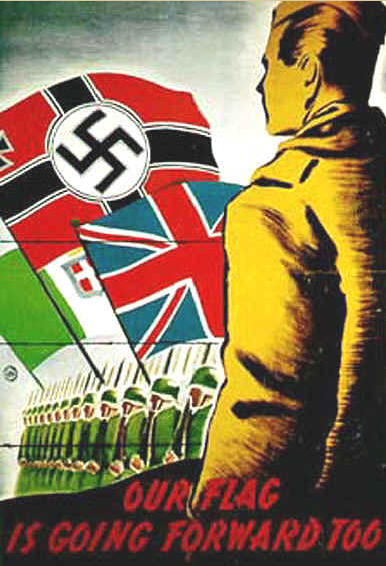
British Free Corps recruiting poster
Throughout all this time, while being distrusted by the British prisoners, Brown was gaining evidence of Englishmen broadcasting for the Germans. He acquired intelligence by bribing guards, talking to members of the BFC and from officials at the German Foreign Office where he was trusted.
His loyal staff also notified him of any sites of importance such as anti-aircraft positions or factories that they had seen on their regular shopping trips for camp supplies. Brown reported these back to London by coded letters as potential targets for bomber attacks.
Patriotic Ally
In an effort to show that German culture was superior to that of the Allies they brought in famous artistes to entertain the troops in the camp theatre. These included singers, pianists, violinists and dancers, Brown even arranged for the POW band and actors from Blechhammer to be brought to Berlin to perform the Mikado, the comic opera by Gilbert & Sullivan.
As British SNCO in charge Brown always met the entertainers beforehand. One day he was introduced to a singer by the name of Frau Strohm, during his conversation with her he realised that she was the famous English opera singer from Wigan, Margery Booth. Initially she was told that she could only sing in Italian, Spanish and German but when allowed to sing in English she included patriotic songs and always finished off with Land of Hope and Glory, much to the annoyance of the Germans. It was an unwritten understanding though that the Germans in the audience could get up and leave if they so wished.
However Margery moved in high circles and she had been given personal assurance by Hitler and Goebbels that they would deal with the matter personally if she were insulted because of her British birth. In a later interview in the Liverpool Echo in 1946 Margery said: 'I carried on singing but was never pro German. I sang for two hours every fortnight to the POW’s'.
A photograph has survived of her performing on stage at Genshagen, she is wearing a full length dress with poppy motifs, a point not lost on Brown. Realising where her loyalties lay he struck up a friendship and eventually revealed his plans to gain intelligence about British collaborators. In his memoirs he says, 'I was extremely moved the first time I heard her sing but I did not know then I was to have to trust her implicitly'. Margery was about to enter a world of intrigue, espionage and danger.
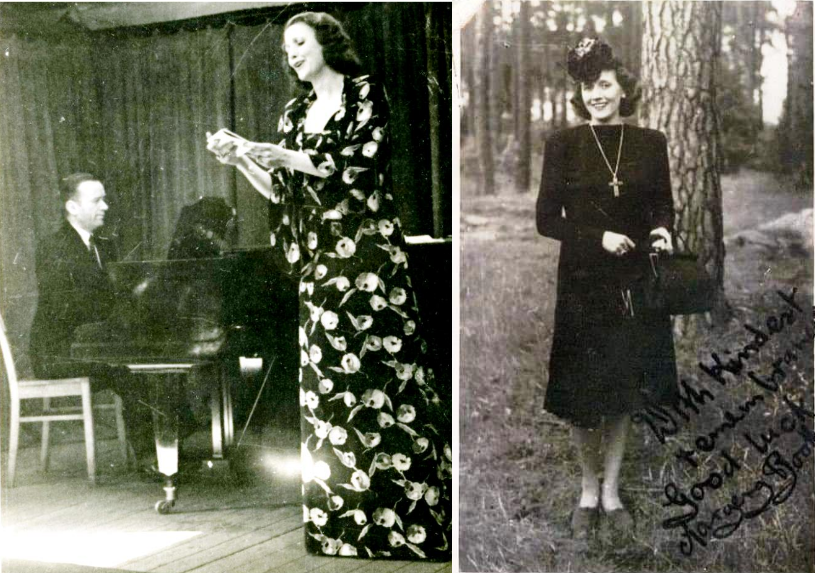
Margery Booth at Genshagen POW Camp © Trevor Beattie
For the next year and half Margery helped Brown in his intelligence gathering mission, She was in contact with top officials of the Nazi Party and diplomats and was in an ideal position to gain important information. As well as aiding Brown, she hid a Jewess in her flat for nine months and helped other evaders. She took considerable risks, and if her activities had been uncovered she would have faced certain death.
Barney Roberts, a Tasmanian who was at Genshagen for a holiday, met Brown who showed him his room. On the wall was a signed photograph of a famous opera singer. Roberts thought it was the opera singer Elisabeth Schwartzkopf but it was almost certainly a photo of Margery as Brown told him it was a personal gift from a wonderful lady.
Prior to meeting Brown, Margery had separated from Egon, their marriage being later dissolved. (Margery's close friend Dorothy Martland later revealed that it wasn't a happy marriage and that Egon spent all her money). As a single woman again she was free to use her flat to help the country of her birth.
She regularly arranged for prisoners from Genshagen to visit the State Opera House with a guard to see one of her performances. Afterwards prisoner and guard would be invited back to her flat for a meal. One such prisoner was Signalman J. Uttling from Liverpool who had been captured on Crete. At Genshagen he was given the job of stage manager. Margery later complimented him on his work on the stage scenery despite having limited materials.
After the first batch of holiday makers had left Genshagen the camp was badly damaged in an air raid. Brown had told London of a Daimler Benz factory six miles away in the Marienfeld district that was manufacturing Mk III Panzer tanks. The plant was bombed but stray bombs fell on the camp as well. The permanent staff were sent to temporary accommodation while repairs were carried out.
Brown received a message from London asking him to verify the identity of Englishman John Amery who was broadcasting propaganda from Berlin and whose idea it was to form the British Free Corps. To do this Brown needed to get out of Genshagen and into the city, so persuaded Dr. Hesse of the Foreign Office to issue a special identity card (Ausweis) which allowed him out of camp unescorted.
The Germans provided civilian clothes which were kept in a wardrobe in the Kommandatur (camp administration centre). So not to antagonise his fellow prisoners further he left the camp in uniform with the clothes in a suitcase and changed in a field.
Through Thomas Bottcher (real name Thomas Heller Cooper) a member of the British Free Corps, Brown set up a meeting with John Amery at the Hotel Adlon, situated in the city centre opposite the Brandenburg Gate. While seeming sympathetic to his cause, he managed to get Amery to talk about his activities and reveal his identity.
John Amery was born 12 March 1912 in Chelsea, the son of Leopold Amery, the Secretary of State for India in Winston Churchill’s wartime cabinet. Coming from a privileged background he was sent to Harrow to be educated but proved to be a rebel and left after a year.
Amery turned out to be an eccentric playboy who carried his teddy bear everywhere with him. He had a love of fast cars and fast women and at one point had picked up 74 motoring offences. He tried a career in film production, setting up a number of companies, these ultimately failed leading to his bankruptcy in 1936.
Amery who was an ardent Fascist with a hatred of Jews and Communists then went to live in France with his girlfriend. His fascist views led to him getting involved with the Spanish Civil War and becoming a gun smuggler for General Franco. He remained in France after the German invasion in 1940, living in the unoccupied zone run by the Vichy Government.
In September 1942, Amery obtained a permit to visit Berlin and consulted with the German English Committee, a body set up to seek out fascist sympathisers among the British. He suggested the Germans should form a British anti-communist legion, one whose members would be native born Britons with right wing views and fascist sympathies. He called it 'The British Legion of St. George'. Hitler was greatly impressed by the articulate Amery and his ideas, even giving his permission for him to remain in Germany as a personal guest.
In 1943 Amery started to recruit for a unit aimed at employing 50 to 100 British men for propaganda purposes. He considered that a prime source for such recruitment would be among disillusioned inmates of the PoW camps in Germany. However the Germans called the proposed new unit the British Free Corps, belonging to the Waffen SS. Amery was sidelined to propaganda radio broadcasts and in late 1944 travelled to Northern Italy to support Italian dictator Benito Mussolini, who had been ousted from power the previous year.
Now with the freedom of the city, Brown was able to rendezvous with Margery outside of the camp. He visited her flat and they would meet up at the Berlin Opera House and also the Cafe Vaterland, a nightclub in Potsdamer Platz in central Berlin. The Cafe, the largest in the world, was inside the enormous Haus Vaterland (House of the Fatherland), a themed pleasure palace based on the Coney Island entertainment area in New York.
It contained a cinema, numerous themed restaurants and ballrooms and could accommodate 8,000 people. It was badly damaged, along with the Berlin Opera House in the bombing raid on 22 November 1943 that destroyed much of the city centre. It was in the Cafe Vaterland that Brown met a German girl by the name of Gisele Maluche, who was to become his mistress. Her flat was a useful base to have in the city from which to carry on his dangerous game of espionage.
The Mysterious Lieutenant Calthrop
On 20 April 1944 a Lieutenant from the Royal Sussex Regiment, who went by the grand name of John Boucicault de Suffield Calthrop arrived at Genshagen. He told Brown that with the authority of Lieutenant Colonel Kennedy the Senior British Officer at Rotenburg, he was to take control of the holiday camp, but that Brown would remain as man of confidence. After conversations with him Brown became suspicious of the newcomer and of his reasons for being at a camp for other ranks when officers had their own holiday camp at Schloss Steinburg. It was to be a complication that Brown could have done without
Calthrop was commissioned into the 5th Battalion Royal Sussex Regiment, a Territorial Army unit in September 1938. His regiment went to France as part of the British Expeditionary Force on 7 April 1940. He was captured in Belgium on 31 May and sent first to Oflag VII-C located at Laufen Castle on the Austrian border, then the following year transferred to Oflag VI-B at Warburg in Westphalia.
In September 1942 he was transferred yet again to Oflag VII-B at Eichstatt in Bavaria. It was here that Calthrop who had a background in theatre and film first made approaches to the Germans and expressed an interest in being involved in the film industry. He made them aware of his thoughts on the Jewish question, his anti-communist views, his links to the fascist Sir Oswald Moseley and that he had fought in Spain for General Franco.
Nine months later in June 1943 he was escorted along with two other prisoners to a private villa in Kaun Strasse, in Zehlendorf, south west Berlin. The establishment was a prototype of the holiday camps that were to be introduced the following year where the Germans tried to identify potential recruits to the British Free Corps.
At Zehlendorf, Calthrop approached Dr. Hesse of the German Foreign Office, with a proposal that he be involved with the editing of films that the Germans were showing at POW camps, along with the English films that were coming through from the International YMCA. Dr. Hesse who it is said to be the last person to conduct negotiations with Britain on the eve of war, took him to the offices of the UFA film studios to meet officials.
Calthrop's stay at Zehlendorf was cut short when the camp was shut down prematurely because of the threat of increasing bombing raids on the capital. A new officers holiday camp opened the following year at Schloss Steinburg, near Straubing in Bavaria.
The camp inmates were evacuated en masse to Stalag IIIA at Luckenwald. Then Calthrop and others spent a short time at Stalag III-C at Küstrin before being sent to Oflag IX-A/Z at Rotenburg an der Fulda, near Kassel. Here he undertook the role of entertainments officer.
Undeterred Calthrop continued in his quest to return to Berlin and be part of the film industry and wrote to Dr. Hesse at the Foreign Office, reminding him of his earlier visit to Zehlendorf the previous year. His determination paid off and on 18 April 1944 Calthrop received a movement order that he was to be transferred to the other ranks holiday camp at Genshagen.
At Genshagen, Calthrop took a great interest in the camp theatre. After seeing Margery perform one of her shows he became besotted and pursued her at every opportunity. He admitted to being passionately in love with her and told Brown he would divorce his wife in order to marry Margery after the war.
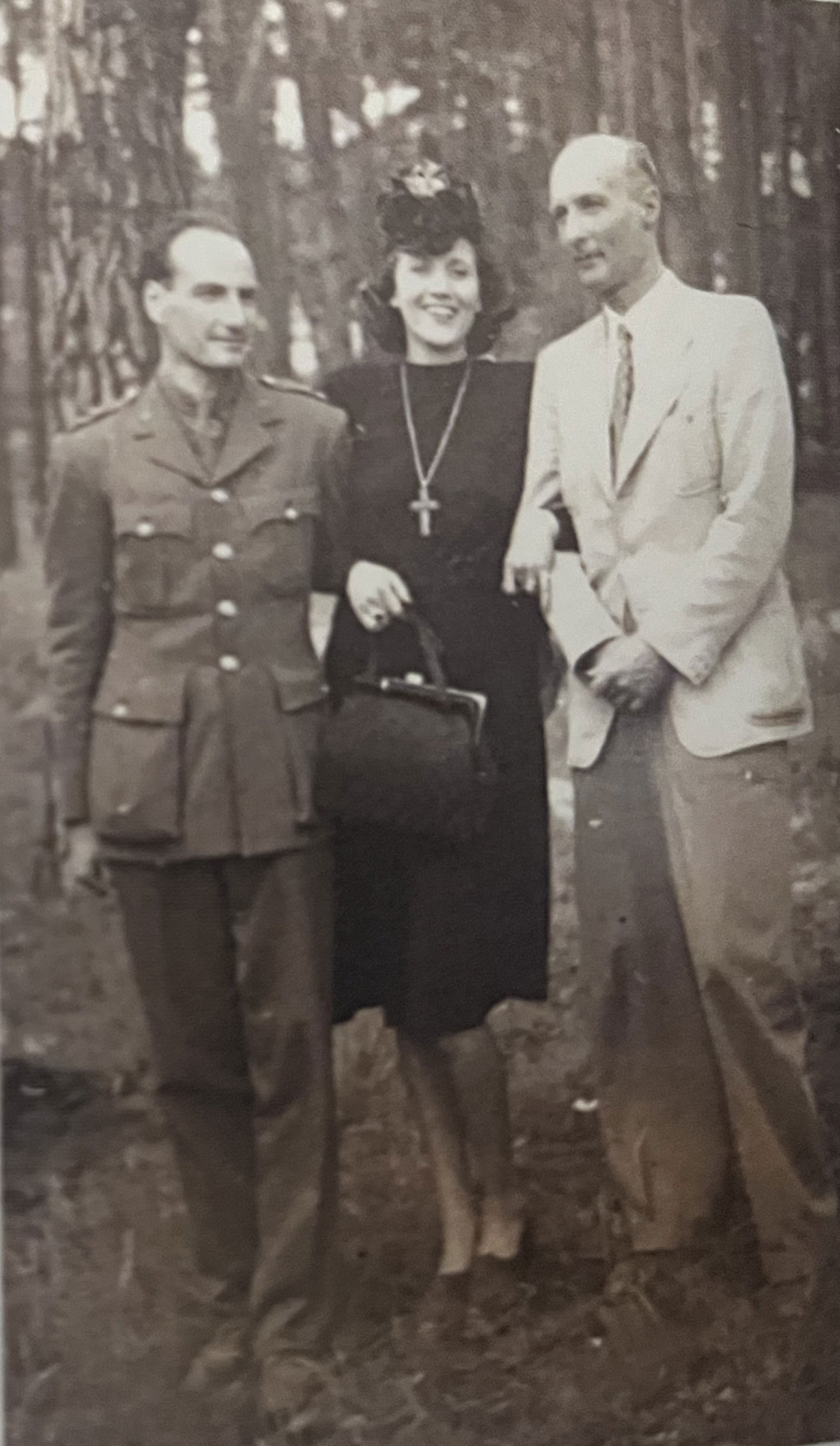
Lt. John Calthrop, Margery and Dr. Ziegfeld of the German Foreign Office at Genshagen POW Camp © Trevor Beattie
In order to entrap Calthrop, Margery played along and pretended to fall in love with him. She provided tickets for him to watch her perform at the State Opera. They visited the Cafe Vaterland for meals and he visited her rehearsal rooms and even her flat, but always with an escort. She set the boundaries by telling him they mustn't compromise each other in any way. Telling him if he disclosed their affair she would not see him again.
In a blatant disregard of his orders, he exceeded his authority at the camp by having a series of interviews with various German officials. He had met with Dr. Arnold Ziegfeld, Dr. Hesse's superior at the English Section of the Foreign Office, both at Genshagen and at his private address at 9 Parade Platz in Tempelhof. Here he was informed of a project to make a film of POW camp life sponsored by the International YMCA in Sweden.
Sonderführer Meyer, the senior German at Genshagen escorted Calthrop to see Major Heimpel, the Kommandant of Stalag IIIA which had authority over Genshagen. They also travelled to the UFA Film Studios for an interview with Fritz Tietz, the editor of Deutsche Wochenschau (The German News Reel Film). Thomas Cooper took him for an interview with Herr Seeburg the editor of 'The Camp' newspaper and a member of the England Committee at his flat in the Wilmersdorf district of the city.
He was issued with an Ausweis signed on Himmler's behalf, allowing him to go anywhere within Greater Berlin in civilian clothes accompanied by a German escort. He also had unrestricted access to the camp telephone, ostensibly to call Dr. Ziegfeld, the Swiss Protecting Powers or the International YMCA organisation, but he used it for other purposes as well. In Berlin he met the traitor John Amery.
In July the Germans sent Calthrop back to Rotenburg. There he gave a lecture to 400 officers describing his time at Genshagen. Afterwards he received criticism and threats from some prisoners for his pro German views. One Prisoner said he felt nauseated by what he had heard. From Rotenburg Calthrop went to Stalag IX-A/H at Spangenberg to give a talk to the two camps there. At Spangenberg Upper Camp he was refused permission by the Senior British Officer Colonel Miller. Not least because the camp contained Major General Victor Fortune who had commanded the 51st Highland Brigade. He was the most senior British officer held as a POW by the Germans. The next day however Calthrop was able to give a lecture to 200 officers at Spangenberg Lower Camp.
Calthrop returned to Berlin where he hoped to further his plans to be involved in film production and renew his association with Margery. Instead of resuming his role at Genshagen he was sent to the main camp at Stalag IIIA in Berlin. Here Major Heimpel who did not trust him, had him arrested for travelling without an escort and arranged for him to be returned to Spangenberg.
Not wanting the other officers to know of his presence at Spangenberg he feigned illness and arranged with the German Kommandant to be put in a German civilian hospital outside the camp. After a month in the hospital he was visited by 63 year old Dr. Vivian Stranders of the Waffen SS.
Stranders was candid in his conversation with Calthrop, revealing that he was British born and was an intelligence officer in the Royal Flying Corps during World War One, holding the rank of Captain. He had been arrested in France in 1926 for industrial espionage on behalf of Germany and was sentenced to two years imprisonment.
He emigrated to Germany in 1928, joined the Nazi Party in 1932 and took German citizenship in 1933. During the Second World War he became a SS officer specialising in propaganda and working with British POW's. He was member of the Anglo-German Fellowship and didn't believe that the formation of the British Free Corps was the way forward.
He boasted that he was a personal friend of Hitler whom he had first met in 1931 and that he had recently been appointed to the Nazi Schutzstaffel (SS) headquarters as an expert on the United Kingdom, with the rank of SS-Sturmbannführer (equivalent to Major). In this role he had been ordered to investigate the progress the British Free Corps, (as John Brown was soon to find out to his cost).
On 23 August Calthrop was transferred to Oflag 79 at Brunswick, near Hanover, again taking on the role of entertainments officer. His Senior British Officer at Oflag 79 Lt. Colonel W.D.E Brown of the Royal Artillery sent word to MI9 in London on 17 November 1944. warning that Calthrop was a suspicious character. MI9 asked MI5 to investigate his background prior to his military service.
Calthrop was born 28 March 1914 in St. Pancras, London. He was to take to the stage like his father, film actor Donald Calthrop. In November 1932 he became engaged to Miss Joan Cassels Ford, the daughter of Sir Patrick Ford, Conservative MP for Edinburgh North. The pair were working together in theatre production at the Grafton Theatre in Tottenham Court Road. Miss Ford was Chairman of Vadis Production who were leasing the Grafton.
The following year and before their marriage Joan gave birth to their son Michael. The couple eventually married in 1934 at the British Consulate in Madeira. Prior to the war they were living at 29 St. Peter's Square in Hammersmith. His wife was now living at 20A Queens Gate Mews in Kensington.
Of special interest to MI5 was the discovery that he was a personal friend of Sir Oswald Moseley, the founder of the British Union of Fascists and had assisted him during his 1931 general election campaign. The matter was raised with the Under Secretary for War in Whitehall as Calthrop claimed to be working for British military intelligence.
In December 1944, MI5 sent a circular to the senior officers at all the Passenger Ports to be on the lookout for Lieutenant John Calthrop, POW number 759, who was suspected of collaborating with the enemy. He was to be detained and sent to No. 90 Reception Centre at Chalfont St. Giles in Buckinghamshire.
In early 1945, still harbouring ambitions to return to Berlin Calthrop wrote to Zeigfeld at the Foreign Office for assistance but the reply back wasn't very encouraging. Finally he wrote to Dr. Stranders seeking an interview. A few days later he received a visit from an English speaking Unteroffizier named Koss. He had brought a message from Stranders saying that if Calthrop would co-operate he would be granted his unconditional freedom and they could discuss furthering his film project.
It was proposed that Calthrop be returned to England to arrange for the immediate release of 500 British officers as a good will gesture. However following the bombing of Dresden by the Allies between 13-15 February, which resulted in the death of 25,000 civilians the plan was vetoed by Hitler.
He was also asked to write letters to his father in law Baronet Sir Patrick Ford, now an ex-MP, and other prominent people in an endeavour to get a question asked in the House of Commons as to whether the British Government approved of the maltreatment and rape of German women by their Russian Allies. (It is not known if these letters were sent, in his statement after the war Calthrop states that he told Koss he would think about it).
However four days later Calthrop received orders to leave at a hours' notice. He says that before he left he took the precaution of giving Lt. Colonel Brown the Senior British Officer two channels of contact through which he could be contacted. firstly through the waiter Jimmie at the Haus Vaterland, any messenger was to ask for the gentleman who buys roses. Secondly through Margery Booth, addressed to 'Die Rosenkavalier', (The Rose Bearer, a comic opera by Richard Strauss).
On 24 March 1945 Unteroffizier Koss duly arrived and escorted him to the HQ of Amptsgruppe 'D' at Fehbelliner Platz in Berlin. There Dr. Stranders informed him that he was the head of the British Free Corps, but he had now ceased recruiting members. Since the previous month he had been working on 'Operation Koniggratz', a propaganda campaign aimed at British prisoners of war, based at Kirchhain near Kottbus where there were 64 British other ranks.
Stranders took Calthrop to see a top Nazi official, SS-Obergruppenführer und General der Waffen SS, Gottlob Berger at his HQ in Douglas Strasse. Gottlob was now in charge of all POW camps in Germany. The General suggested that he take charge of a new scheme for the distribution of Red Cross parcels from Lübeck where they were to be distributed in Swedish lorries with British POW drivers. Calthrop accepted the offer subject to Red Cross approval. He also wrote to Colonel Brown at Brunswick informing him of his intentions. He was unaware that Heinrich Himmler, the Chief of the SS had set up his HQ at Lübeck, from where he had contacted Count Folke Bernadotte from Sweden and started negotiations for the German surrender with the West.
Calthrop was moved to Berger's personal HQ in Kinderplatz, under the care of his Aide de Camp, Oberfuhrer Jacobssen who had been involved in forming the SS Division Viking. After a few days he was informed by Berger that the Lübeck plan had been abandoned owing to difficulties in obtaining a special pass from the Red Cross.
Calthrop was given a temporary Ausweis to go into the city with an escort, but said it was possible to venture out on his own. Which he did on a couple of occasions to seek Margery but she had already fled Berlin.
By now Germany was collapsing fast, the Russians were closing in on Berlin, and the top Nazis were making plans to flee the capital. Calthrop had mentioned to Berger that he had political ambitions so it was suggested that Calthrop return to England, stand as a Member of Parliament and warn his compatriots about the danger of Bolshevism and the need to be lenient towards Germany post war.
Calthrop agreed to this so they came up with a plan. He was to be supplied with false papers and the cover story that he was a Hungarian electrician contracted to carry out electrical work on the railway network on the Swiss border.
Arrangements were made through Brigadefuhrer Schwellenberg, chief of the Waffen SS Secret Service. Dressed in civilian clothes and carrying a special Ausweis he left Berlin by train on 3 April 1945 bound for Munich, accompanied by SS Sturmführer Rutger von Gossler.
At Munich they reported to Sturmführer Dauser. Whilst the final arrangements were made with the Frontier Police for the crossing they stayed overnight with friends of Gossler in Prien. The next morning they travelled from Munich to Bregenz in Austria on the shores of Lake Constance, a train journey of 95 miles, and reported to the Wehrmacht Colonel in charge. Initially he refused permission for Calthrop to cross the border but after Gossler threatened to report him to SS General Berger he soon changed his mind. Gossler then left Calthrop to continue his journey alone.
On 12 April Calthrop left Bregenz for the five mile journey to Lustenau on the Swiss border. He had been told to meet Hauptmann Süss of the frontier guard by the third tree along in the avenue outside Lustenau railway station and declare himself as the 'the man from Berlin'.
Süss took him to a railway bridge on the border half a mile away and told him to run across as a train was passing. On the other side in St. Margarethen he was arrested by Swiss border guards. Calthrop then contacted the British Legation in Bern and gave a report of his escape from Germany.
Arrest
In the autumn of 1944 Brown had informed London of a Mercedes Benz factory six miles away from Genshagen in the Marienfeld district that was manufacturing Mk III Panzer tanks. The plant was bombed on 6 October but stray bombs fell on the camp badly damaging it. The permanent staff were sent to temporary accommodation while repairs were carried out.
Shortly after the raid Brown was arrested and confronted by Major Heimpel of the Abwehr and two members of the Gestapo. They had a statement from a British traitor by the name of Walter Purdy giving details of Browns espionage activities.
Walter Purdy was born 7 May 1918 at 270 Boundary Road in Barking, Essex. Before the Second World War Purdy, who had been an active member of the Fascist Party became a Merchant Navy officer. When hostilities started he was transferred to an armed merchant vessel, HMS Vandyke as ship’s engineer.
On 10 June 1940 the Vandyke was bombed and sunk off Narvik in Norway. After 36 hours in a lifeboat he was captured and became a PoW. In 1943 whilst in Marlag-Milag Nord PoW camp near Bremen he decided to defect and work for the Germans. They used him by sending him to different camps to spy on his fellow POW’s under the assumed name of Bob Poynter.
The Germans had placed Purdy in Colditz Castle as a spy. Here Captain Julius Green the Jewish dentist who Brown had met at Blechhammer, inadvertently informed Purdy of Browns role as a spy at Genshagen. The indiscretion also led to the discovery of a tunnel and a hide for contraband in the castle.
Brown denied the accusations and blamed it on some of the Jewish inmates, saying they were out to destroy the idea of a British Free Corps. With reservations the Germans believed him and released him, but Brown now knew that his time was running out. It would have cost him his life if the Germans had believed Purdy's story that he was a spy. Margery Booth would have been implicated as well with dire consequences.
With the Gestapo now suspicious of him Brown taught his secret code to Reg Beattie, one of his staff just in case he was re-arrested. He also passed over secret documents to Margery for safekeeping, these included a list of names of Allied soldiers who had defected and joined the British Free Corps. She said in a later interview that she never let the papers out of her sight and during her performances she hid them in her underclothing. This led to her being called the 'Knicker Spy' by some after the war.
During the war, Crown Prince Wilhem who had befriended Margery at Bayreuth, lived at Schloss Cecilienhof in Potsdam, 17 miles to the south west of Berlin. After the failed assassination plot on Hitler on 20 July 1944 the Gestapo had the Prince put under surveillance. Despite this Margery managed to bury the documents given to her by Brown in the grounds of his palace at Potsdam.
In October 1944 Hitler passed over the responsibility of the POW camps to the Waffen SS. Unaware of the holiday camps up to then they started an investigation into the activities at Genshagen. In December the camp was shut down and Brown and his staff were arrested by the Gestapo. They wanted to know why there were so many well targeted bombing raids at strategic locations around the camp and why the recruitment into the British Free Corps had been such a failure.
This of course was thanks to the efforts of Brown and his staff who had dissuaded British and Dominion troops from going over to the German side. At no time did it reach more than thirty in strength. A small number of men also joined the staff of the Ministry of Propaganda, working for radio stations and magazines. Brown and his staff were kept in a Strafe (punishment) prison for three weeks under interrogation. They were eventually released in mid-January 1945 and returned to Stalag VIII-B at Lamsdorf.
The Great March West
By the start of 1945 the tide of war on the eastern front had turned for the Wehrmacht. On 12 January the Red Army launched an offensive that would see them advance from the River Vistula on the Polish border to the River Oder on the German border.
The German authorities began evacuating the occupants of all nationalities from the POW and slave labour camps in the east to prevent them being liberated by the advancing Soviet Army. This became known amongst other names as 'The Great March West'. There were three main routes, the northern route, ending up at Fallingbostel in northern Germany. The central route to Luckenwalde, south of Berlin, and the southern route which led through Czechoslovakia to Nuremberg and Moosburg in Bavaria.
By 17 January, Warsaw the Polish capital had fallen and the Russian 4th Guards Tank Army were just 75 miles from Stalag VIII-B at Lamsdorf. Brown and his men arrived in Lamsdorf just in time to take part in the evacuation. On 22 January in one of the coldest winters of the century the first column of 1,000 prisoners left the camp to undertake the long trek back to Germany.
Some were in their fifth year of captivity and the malnourished and unfit men were in no condition to undertake such an arduous journey. They struggled each day through blizzards, relying on the meagre rations supplied by their German guards once their red cross supplies had run out. At night they crowded into barns or whatever shelter they could find. The unlucky ones huddled together in the open in freezing temperatures of -20 degrees.
The mortality rate on the march was high, (later it was compared to the Bataan Death March inflicted on American and Filipino soldiers by the Japanese Army in 1942). Many of the sick and weak succumbed to the conditions, and there were instances of stragglers being shot by the German guards. Another deadly hazard was the marauding Russian aircraft which attacked the POW columns believing they were retreating German troops.
Eventually after many weeks, Brown's column reached Bavaria, he and Jimmy Newcombe found themselves in Stalag 383 at Hohenfels just north of Regensburg. It was known to be one of the better camps with good facilities because it had originally been built to be an officers camp, Oflag III C. It was then designated a special camp solely for NCO's who were exempt from work details because of their rank. However over the winter of 1944/45 the prisoner population of 4,000 swelled to over 6,000 owing to the influx of POW's from the camps in eastern Europe.
By the Spring of 1945 the Americans were advancing ever closer, so on 17 April the Germans evacuated the camp leaving behind the sick and injured under the care of medical staff. The prisoners were marched south east via Regensburg and Petzkofen in the direction of Austria. After 60 miles the column was intercepted and liberated in the area of Frontenhausen by units of General Patton's 3rd Army.
To avoid being marched away by their captors to an unknown fate, Brown and Newcombe decided to hide in the camp along with the sick to await the arrival of the Americans. The camp was finally liberated on 24 April by the 51st Armoured Infantry Battalion from the US 4th Infantry Division.
Along with other released POW's Brown and Newcombe were flown to Brussels, the location of the British 21st Army Group Headquarters. On 4 May 1945, the same day that Field Marshal Montgomery accepted the German surrender on Lüneburg Heath near Hamburg, Brown completed a standard questionnaire form that all returning POW's submitted. Instead of being welcomed back and thanked for his contribution to the war effort he was promptly arrested by the Military Police as his name was on a list of suspected collaborators compiled by other repatriated prisoners.
He was placed under open arrest under the supervision of an escort until his story could be corroborated. After some communication between Brussels and MI5 in London he was visited by an officer from SHAEF (Supreme Headquarters Allied Expeditionary Force) who arranged his release.
He was then flown back to England in a RAF plane for a full debrief by MI5 before returning home to his wife Nancy and daughter Marion in Sunbury on Thames, Surrey. Ironically during the war Kempton Park racecourse, a hundred yards from Browns front door was used as a German and Italian POW transit camp, before their transfer to permanent camps.
Fleeing Berlin
In January 1945 Margery was arrested at her flat on suspicion of spying and taken to the Reich Security Main Office headquarters in Prinz-Albrecht Strasse, the headquarters for the SS, Einsatzgruppen, and Gestapo. Here she was held for three days under intense interrogation. She denied any involvement with Brown’s activities and with her captors unable to prove a case against her she was released.
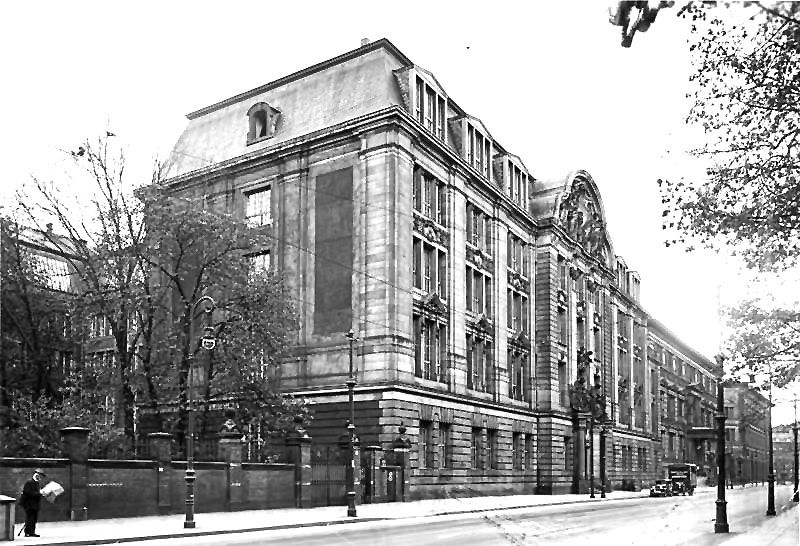
The infamous Gestapo Headquarters in Prinz-Albrecht Strasse, Berlin
Margery was put under surveillance and had to report to Gestapo Headquarters twice a month where she was questioned for two hours at a time. Here she was put under enormous pressure to divulge information and threatened with deportation to a concentration camp.
The single largest raid on Berlin involving over 1,300 U.S bombers occurred on 18 March and resulted in thousands of civilian casualties. Margery later recalled having to soak her raincoat with water before venturing out because of the intense heat.
During another air raid towards the end of the month she fled Berlin with her friend Augusta, who had been her faithful maid of 15 years. They escaped just in time, by 14 April the Russians had encircled Berlin, and by the time the city fell over three quarters of it had been destroyed by Allied bombing and Russian artillery fire.
The pair travelled 145 miles south and made contact with the Americans in the town of Pössneck in Thuringia which U.S troops had captured on 13 April. They were then transferred a further 25 miles to a displaced persons camp at Naila, a small town to the West of Hof in Bavaria.
Margery was to stay at Naila for seven months under the care of the Americans. The years of living in war time Berlin, with the knowledge that discovery would mean certain death, the espionage work with Brown and the strain of hiding Jews in her apartment took its toll on Margery.
Her hair turned white, her nerves were shattered and she could hardly write coherently. She was terrified of leaving the protection of the Americans as she was still a German citizen and believed she couldn't move until the German courts opened again. She was unaware if Brown had survived to vouch for her or if he still had a micro copy of the documents she had hidden in Berlin in the false heel of one of his shoes.
Eventually she wrote to an old friend in Southport for help, 57 year old elementary school teacher Mary Edwards. Despite the difficulties caused by a time lag of about a month between letters, owing to the post war conditions on the continent, Margery applied to the authorities in Lubeck in northern Germany for a U.K visa. Mary also wrote several letters to the British Foreign Office in London on Margery's behalf urging them to assist in Margery's return to England.
In a letter to the Foreign Office dated 1 November 1945 Mary pledged £30 to cover the cost of Margery's transport home and offered to meet her in London and accompany her to the Old Bailey so that she could be a witness in the Walter Purdy treason trial. Mary's efforts eventually paid off and Margery was flown home to London in readiness for the upcoming trials.
The Treason Trials
John Brown was a witness in twenty treason trials including that of William Joyce, John Amery, Walter Purdy, and Thomas Cooper. It is known that Margery Booth was also a witness in the Joyce, Amery and Purdy trials. Having met the accused in Berlin she could vouch for Brown's evidence.
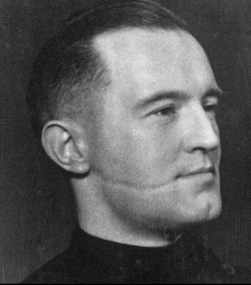
William Joyce
William Joyce's last broadcast was from Hamburg on 30 April 1945 (the same day that Adolf Hitler had committed suicide). Following the Führers death top Nazi officials led by Grand Admiral Karl Donitz formed a government at Flensburg on the Danish border. It was in woods just outside Flensburg on 28 May 1945 that Joyce was arrested by British Intelligence officers from T-Force, a special unit set up to take control of German Media infrastructure.
Upon being challenged Joyce reached into his pocket for his fake papers, under the name of Wilhelm Hansen. Believing he was armed Lieutenant Geoffrey Perry shot him four times, wounding him in both buttocks. After receiving medical attention Joyce was flown back to London to face trial. His wife Margaret was arrested separately by Perry later that day.
Little did Joyce know that the man who had shot him was a Berlin born German Jew by the name of Horst Pinschewer. His parents sent him to England in 1936 where he was educated at Buxton College in Derbyshire. At the age of seventeen Horst moved to London where he worked as a trainee photographer for the Daily Mirror. In July 1940 he was arrested as an enemy alien and was interned at Kempton Park Race Course Internment Camp.
Cleared by a tribunal he joined the British Army, serving as a Private and NCO at No.3 Pioneer Corps Training Centre in Ilfracombe. Following his commissioning as an officer in 93 Company Pioneer Corps in October 1943, he changed his name to Geoffrey Howard Perry.
In 1944 after the D-D Landings he was attached to an Interrogation Unit of the Intelligence Corps where he interrogated captured soldiers in order to determine the German order of battle. He also interviewed captured senior German officers.
Following Joyce's capture, Perry took over Radio Hamburg where he broadcast to the German population. He also helped to set up Die Welt, the German national newspaper and the news agency Deutsche Presse-Agentur (DPA). After the war he formed a successful publishing company before retiring in Palm Beach, Florida. He returned to England in his latter years and died in Elstree, Hertfordshire in 2014, aged 92.
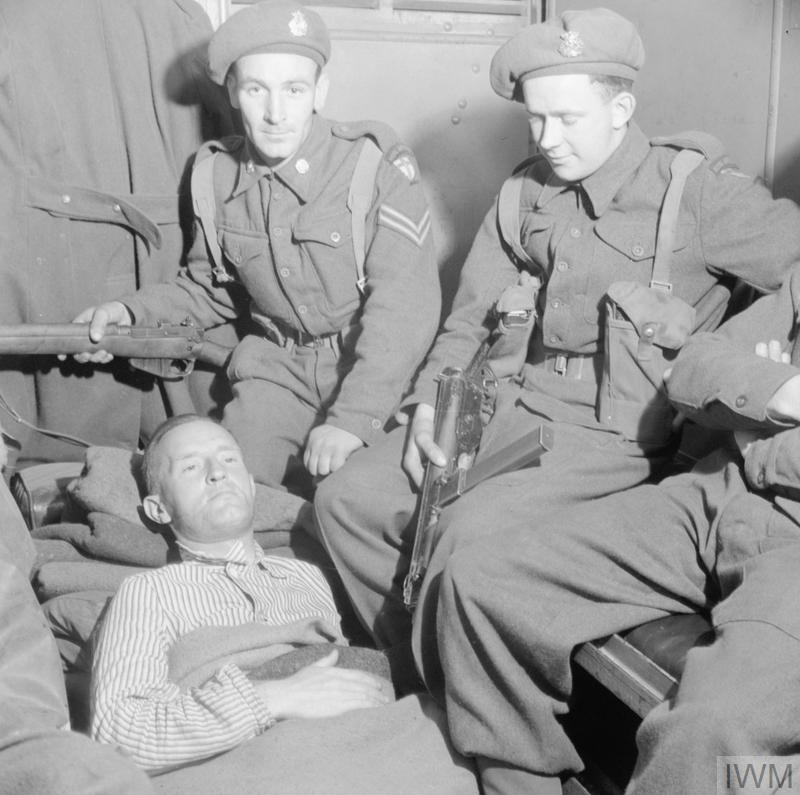
Wounded Fascist politician and Nazi propaganda broadcaster William Joyce under armed guard in a military ambulance after his arrest
On 18 September 1945 Joyce was tried at the Old Bailey on three counts of high treason. He was found guilty and hanged, aged 39, by Albert Pierrepoint on 3 January 1946 at Wandsworth Prison. He has the distinction of being the last person in the UK to be executed for high treason.
As was customary for executed criminals, Amery’s and Joyce's remains were buried in unmarked graves within the walls of HMP Wandsworth. In 1961 a new legislation came into force, allowing burial in a public cemetery or repatriation at the discretion of the Secretary of State.
In 1976 following a campaign by his daughter, Heather Landalo, William Joyce’s remains were re-interred in Bohermore, County Galway in Ireland where he had lived with his family from 1909 until 1922.
Margaret Joyce was not charged with any offence after the war. Some say on compassionate grounds, others that it was a result of a deal made by her husband for not revealing his links to MI5. She drunk herself to death in Dartford in 1972.
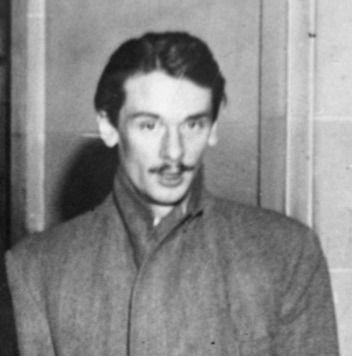
John Amery
On 25 April 1945 John Amery and his French mistress Michelle Thomas were captured near Como by Italian partisans from the Garibaldi Brigade. Amery and Thomas were initially set for execution, but both of them were eventually sent to Milan.
It was at this point that a young Captain, Alan Whicker, then with the British Army Film Unit (later to become one of the most famous faces of television with his TV programme 'Whicker's World') heard that Amery was being kept in a Milan jail.
Sensing a scoop, Whicker, a trained journalist, appealed on Radio Milan for Amery's whereabouts. Within minutes, partisans made arrangements for Amery to be handed over to him. At his trial 33 year old Amery pleaded guilty to eight charges of treason, a move that inevitably meant he faced the death penalty. The entire hearing lasted only eight minutes.
His story came to its dramatic end on the gallows at exactly a minute past nine on 18 December 1945, when he met hangman Albert Pierrepoint for the first and last time. His last words were "I have always wanted to meet you Mr. Pierrepoint but obviously not under these circumstances'.
In 1996 Julian Amery had his brother's remains exhumed from Wandsworth Prison and cremated, scattering his ashes in France.
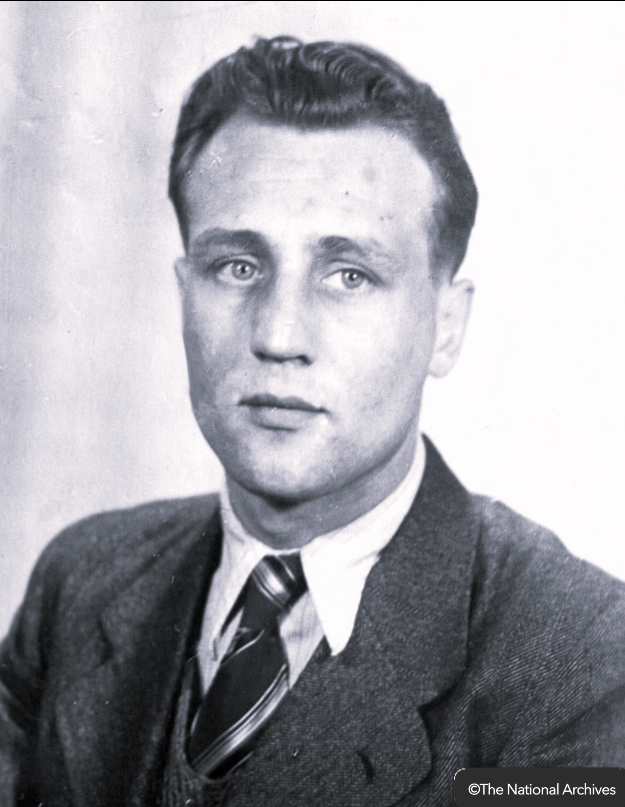
Walter Purdy
Walter Purdy was born 7 May 1918 at 270 Boundary Road in Barking, Essex. Before the Second World War Purdy, who had been an active member of the Fascist Party became a Merchant Navy officer. When hostilities started he was transferred to an armed merchant vessel, HMS Vandyke as ship’s engineer. On 10 June 1940 the Vandyke was bombed and sunk off Narvik in Norway.
After 36 hours in a lifeboat he was captured and became a PoW. In 1943 whilst in Marlag-Milag Nord PoW camp near Bremen he decided to defect and work for the Germans. They used him by sending him to different camps, including Colditz Castle, to spy on his fellow POW’s under the assumed name of Bob Poynter.
At Colditz he betrayed Brown to the Germans after hearing about Brown’s activities from another prisoner, dentist Julius Green, who like Brown was also sending information back to the War Office by code. It would have cost Brown his life if the Germans had believed his story that Brown was a spy. Margery Booth would have been implicated as well with dire consequences.
At the end of the war, Purdy was picked up by American forces and returned to England. For a while he remained at liberty, and was even awarded a disability pension based on wartime hardships. Conveniently forgetting his German lover Margarete Heumeyer and their son Stephen Robert Willi Heumeyer, he started an affair with a Mrs. Betty Blaney. Discovering about his past she began to blackmail him, but eventually ended up in the dock at the Old Bailey charged with extortion.
All this time, Scotland Yard had been preparing a case against Purdy. On 18 December he faced the Attorney General, Sir Hartley Shawcross, on a charge of High Treason. Margery gave evidence at his trial along with John Brown, Colonel William Tod the Senor British Officer at Oflag IV-C at Colditz and the MI9 agent, Captain Julius Green of the Royal Army Dental Corps.
At the Old Bailey Purdy was initially sentenced to death The execution date was fixed for February 8 1946. On February 7, the day before that date, the Home Secretary commuted Purdy's death sentence to a life sentence. After being released on parole in 1954, he led a quiet life away from the limelight in Essex where he worked as a quality control inspector at the Ford car plant in Dagenham.
He was described by a work mate as not a very nice man, ready to drop people in it. The Governor of Parkhurst prison on the Isle of Wight said he was anti British and a trouble maker. MI5 described him as the 'greatest rogue unhung'.
In 1957 he changed his name to Robert Wallace Poynter, names he had used as aliases in Germany. That year he married Muriel Ainslow who he had known before the war. After her death in 1960 he married divorcee Varetta Wallace. Both women were unaware of his activities during the war. He retired to Thundersley near Southend-on-Sea in Essex where he died in 1982 of lung cancer, aged 64.
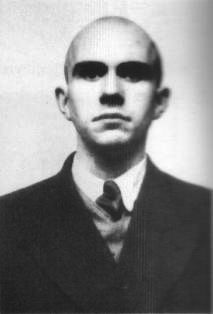
Thomas Cooper (alias Thomas Böttcher)
Thomas Heller Cooper was born 29 August 1919 born in Chiswick, London to an English father and a German mother. In 1937 he attempted to join the Metropolitan Police, Royal Navy and the Royal Air Force but was rejected each time because of his German heritage. Disillusioned he joined the British Union of Fascists in September 1938.
A fluent German-speaker, Cooper contacted the German Academic Exchange Organization in London. He was eventually offered a place at the Reich Labour Service office in Stuttgart during the summer of 1939. On the outbreak of the Second World War in September 1939 he was arrested for being an enemy alien but after producing a certificate showing that he was an ethnic German or Volksdeutscher he was offered the opportunity of joining the SS.
He underwent training at the 1st Waffen SS Panzer Division Leibstandarte SS Adolf Hitler at the Berlin Lichterfelde Barracks under the assumed name of Böttcher (a literal translation of his real name of Cooper). In July 1940, he was transferred to the 8th Company, 5th Totenkopf Infantry Regiment based at Oranienburg to the north of Berlin, tasked with training recruits. In February 1941 he was moved to Plocki in German occupied Poland. Promoted to SS-Rottenführer he attended the SS NCO School at Lauenburg in Pomerania for a three month training course.
On completion he was posted to the SS Totenkopf Wachbatallion Oranienburg, stationed near Krakow, it was here that he would later boast that he participated in massacring both Polish Jews and Russian prisoners of war. Here he was promoted to SS-Unterscharführer in November 1941.
Cooper was badly wounded in both legs fighting on the Eastern Front in February 1943. He was awarded the Silver Wound Badge, becoming the only Englishman to receive a German combat decoration during the Second World War. On recovery he was transferred to the British Free Corps, promoted to Oberscharfuhrer and assigned to a transit camp for new recruits to the BFC at a villa in the Grunewald, a forested area to the west of Berlin.
It was at Genshagen that John Brown met Cooper, who confirmed the existence of the British Free Corps and arranged for Brown to meet John Amery at the Hotel Adlon in Berlin.
Cooper and the remnants of the British Free Corps surrendered on 2 May 1945 to advancing American forces. He was promptly handed over to the British and imprisoned in a military prison in Brussels.
In January 1946 John Brown gave evidence against Cooper at his trial for high treason at the Central Criminal Court. He had been hoping that Brown, whom he thought was a fascist sympathiser could be used in his defence but was very surprised when Brown was called to be a witness for the prosecution. Cooper was found guilty and sentenced to hang, but days before his scheduled execution, the sentence was commuted to life imprisonment.
He was released In January 1953. after serving seven years, and is believed to have emigrated to Japan, settling in Tokyo where he converted to Buddhism and became a language teacher. He subsequently returned to England and is reported to have died in 1987, aged 67.
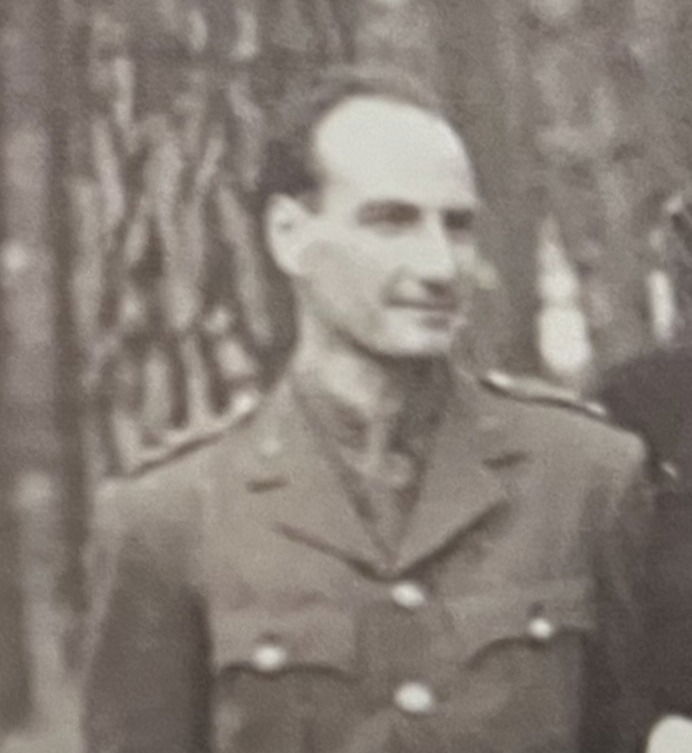
Lt. John BS Calthrop
Despite being denounced as a collaborator by Brown and others, John Calthrop didn't face treason charges after the war. He was interrogated by Lt. Colonel Seymer of the MI5 on 28 April 1945 in room 55 at their offices in Saville Row in London.
Calthrop made a very long and detailed statement in which he tried to justify his actions as a POW. He claimed that his first aim was to gain intelligence for transmission back to England (even though he had no means of doing so). Secondly to make films with the Germans to be shown at POW Camps.
In his report Lieutenant Colonel Seymer thought that Calthrop's motives were purely selfish in order to gain privileges, comfort and relative freedom, along with the luxuries that entailed. He described him as being too conceited to accept his position as a prisoner of war. Seymer also remarked that he didn't seem to understand that although fraternisation wasn't an offence collaboration was.
He also added that Calthrop's statement stinks and he would like to see him court martialed. However on the present evidence only a minor charge of 'Conduct unbecoming of an officer and a gentleman', or 'Conduct prejudicial to military discipline' is likely, unless more evidence arises for a more serious charge.
Some of the annotations added in the margins of Calthrop's report included 'sailing close to the wind'... 'a pompous ass and a hypocrite'... and 'playing with fire'.
Calthrop was very lucky that none of the many schemes he was involved in ever came to fruition otherwise he would almost certainly have suffered the same fate as Joyce and Amery and met Albert Pierrepoint on the gallows.
After the war he and his wife Joan divorced. He was married for a second time to Elizabeth Schofield in 1958 in Kensington. John Calthrop died in December 1977 aged 63 and was buried in Fornham St. Martins on the outskirts of Bury St. Edmunds in Suffolk.
Executioner
Amery and Joyce's executioner Albert Pierrepoint, had learned his grisly trade from his father Henry and uncle Thomas, both official executioners. In his career he carried out at least 434 executions, including 226 war criminals between 1945 and 1949.
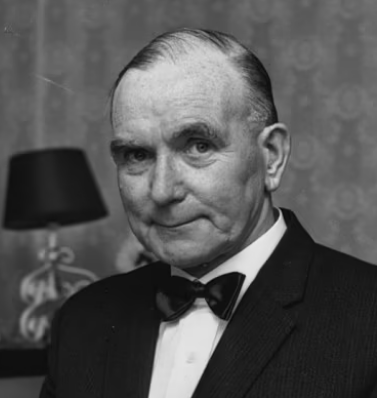
The hangman - Albert Pierrepoint
Albert kept a notebook detailing every execution he had carried out. It included the victim's name, age, height, weight, place of execution and the names of his assistants. He used a formula to calculate the length of drop required at the gallows to ensure a swift and successful hanging.
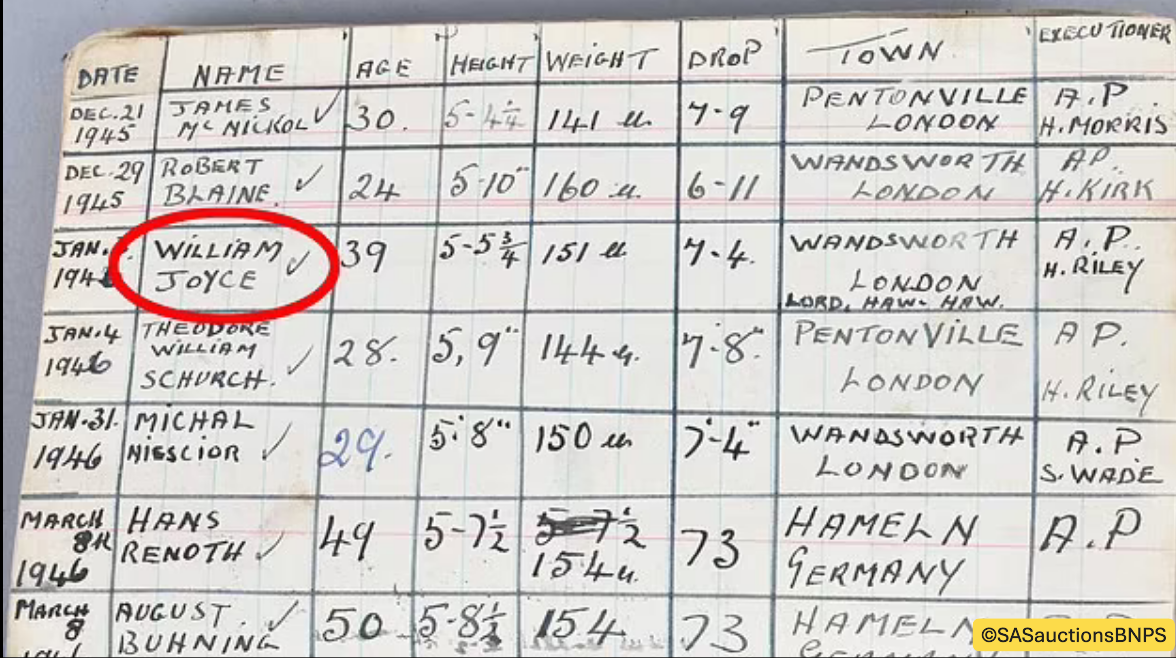
Pierrepoint's notebook with the name of William Joyce highlighted.
By a strange quirk of fate Albert Pierrepoint and his wife Annie retired to Margery’s home town of Southport in the 1960’s. Albert spent the last four years of his life in a nursing home, just a couple of miles from Margery’s old home in Lethbridge Road, where he died in July 1992, aged 87.
Post War Germany
In Wieland Strasse today, the street that Margery and Egon lived in, are grim reminders of the dark days of the war. Outside eleven of the houses are Stolpersteine (stumbling blocks), concrete blocks measuring 10cm x 10cm which are laid into the pavement in front of the last voluntarily chosen place of residence of the victims of the Nazis. Their names and fate are engraved into a brass plate on the top of each Stolpersteine.
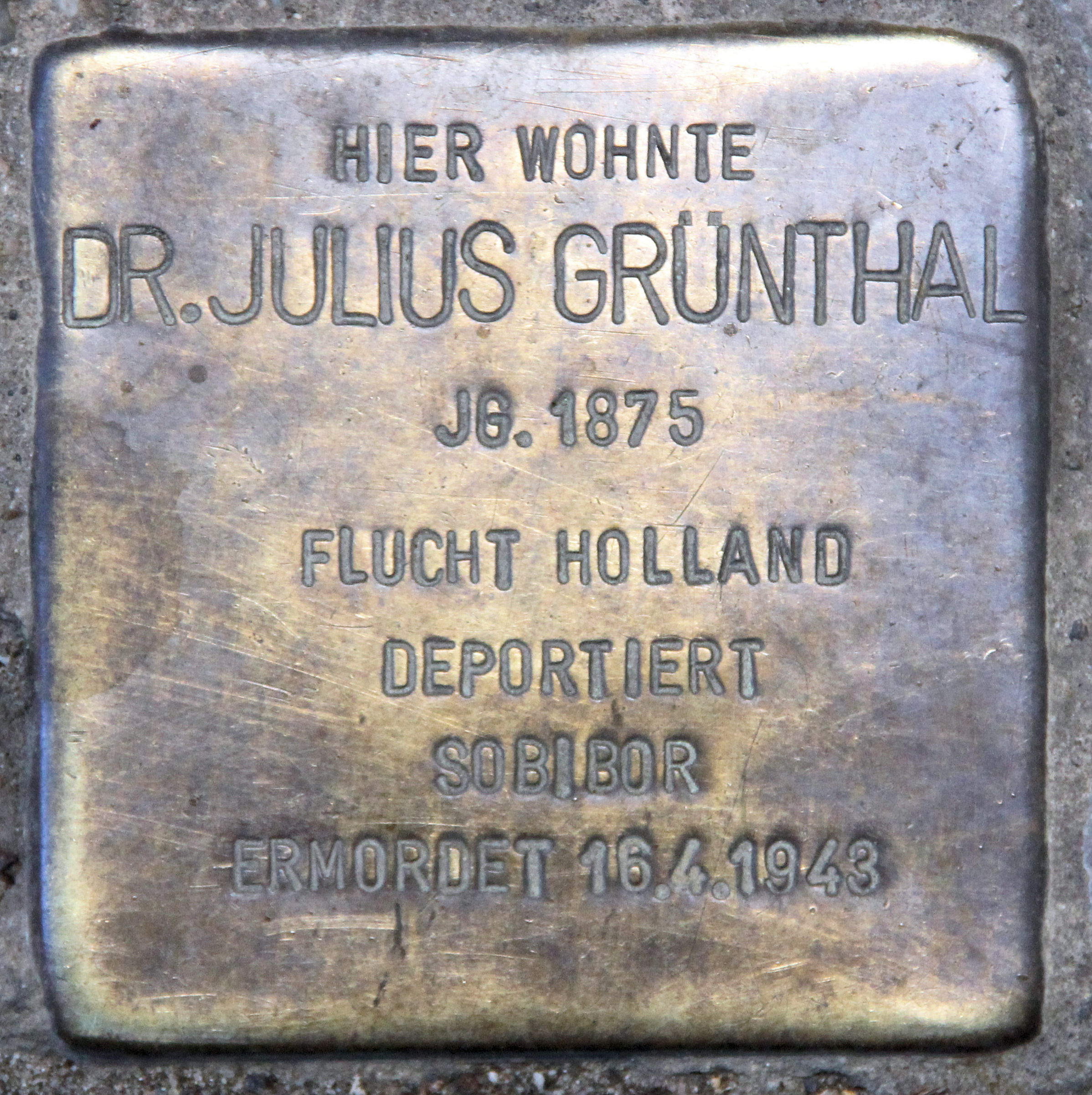
Stolpersteine in Wieland Strasse, Berlin commemorating Dr. Julius Grunthal
A total of 57 Jewish residents of Wieland Strasse who were murdered in the holocaust are commemorated today. A next door neighbour of Margery and Egon’s at number 8 was Dr. Julius Grunthal. He moved to Holland to escape persecution, but when that country too was invaded he was eventually rounded up and deported to the extermination camp at Sobibor in Poland, where he was murdered on 16 April 1943, aged 68.
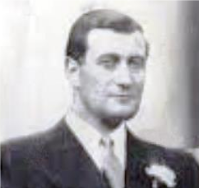
Dr. Egon Strohm
Egon Strohm continued to live in Berlin after the war, earning a living as a radio presenter and commentator. He also became a writer for newspapers, articles and magazines, as well as a part time actor. In 1946 he wrote a semi-autobiographical novel entitled ‘Schmerzvolle Reise’ (Painful Journey), which was loosely based on his own life with Margery: A brief synopsis follows:
'Christian Messmer is presented as a student of economics who resides in a lodging house in Berlin, here he meets a young English music student by the name of Anne Willoughby. He lives on his father's money, gets involved in romances and does not know exactly what he wants in life. Then his father loses his business and property. Deprived of financial help Christian subsists on tutoring and appearing as a bar pianist.
With Anne’s help, he decides to go to London as a teacher. However after spending all his money on drink he goes on a journey around the country, gets by with odd jobs, and finally finds shelter with the Bottlethorpe working-class family.
Lewis Maxwell, a trades union representative, gets Christian a job collecting union membership payments. Then after discovering Christian's real talent of writing, Lewis Maxwell reveals himself to be the son of the Cuthford-Grisby family, who own the majority of shares in a newspaper company.
Christian has finally found his calling, after publishing his first article he is commissioned to write an Encyclopedia on Employment and the Trade Union movement.
Meanwhile Anne Willoughby has become a famous pianist. When he discovers she is travelling to England for a concert he decides to contact her again. The pair admit to having waited for each other, romance blossoms and they get engaged to be married.
However the story ends in tragedy in 1935 when Anne has a fatal accident on the train journey back to Europe. A grief stricken Christian then returns to Germany to his parents' home’.
On 14 March 1948, Egon along with eight others from Germany and Austria boarded an American Airways flight in Frankfurt and flew to New York, courtesy of the Washington Court of Justice. They were required to testify in a treason trial against Robert Henry Best, the party included a scientific advisor to the German Foreign Office, a programme director from the Austrian Broadcasting Service, a technician from Radio Munich, a translator and a former acting superintendent from the short wave radio station Berlin that Egon once worked for. Egon described himself as a radio commentator on art, literature and music.
The party was met in New York by a federal agent and a policeman and taken by train to Boston where the accused was on trial. Best had been an American correspondent who covered events in Europe during the interwar period, living in Vienna for 20 years. He was charged with twelve acts of treason by broadcasting propaganda on Berlin State Radio to the USA Zone.
Best was found guilty and sentenced to life imprisonment. Best served his sentence at the Federal prison in Danbury, Connecticut. On August 12, 1951, he was later transferred to the Medical Centre for Federal Prisoners in Springfield, Missouri. Best died there of a brain hemorrhage on 16 December 1952.
In 1953 Egon acted in the successful film 'Martin Luther', which had been made in Germany. In it he played the part of Cardinal Alexander, the special emissary to Pope Leo X I. In 1960 he appeared in the film 'Man on a String’, a spy thriller made in Berlin starring Ernest Borgnine where he had an unaccredited role playing a hotel concierge.
After writing four radio plays Egon then became a literary translator, creating German language versions of numerous best-selling books, including 'Watership Down' by Richard Adams. Egon Strohm died in Berlin on 2 May 1983 aged 78.
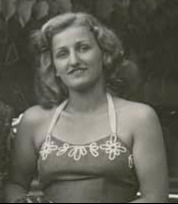
Winifred Wagner
After the collapse of the Third Reich a denazification court banned Winifred Wagner from the administration of the Bayreuth Festival and its assets. The responsibility of managing the Festspielhaus was passed to her sons Wieland and Wolfgang. During American occupation of the region after World War Two, the theatre was used for recreation and religious services for American troops. Only popular concerts and mixed entertainment were allowed. Eventually, in 1951 the theatre was returned to the city of Bayreuth and the Wagner Festival resumed.
Winifred Wagner died in 1980 aged 82 in Überlingen, on the shore of Lake Constance near the Swiss border. Today the Festival is still as popular as ever and draws thousands of Wagner fans to Bayreuth every summer.
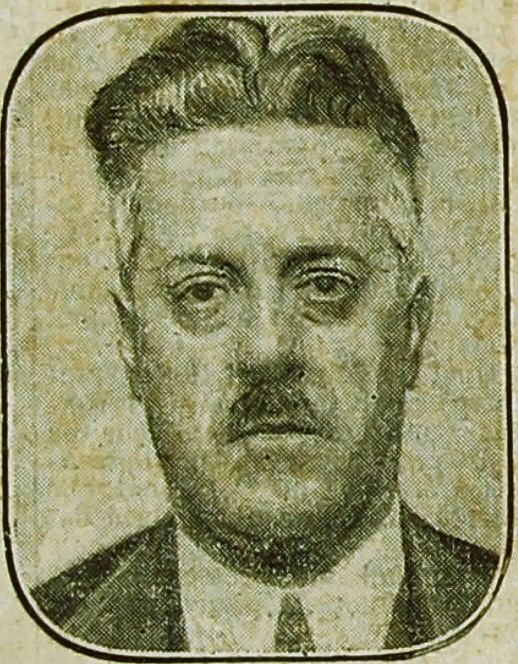
Dr. Vivian Stranders
Vivian Stranders fled Berlin on 12 April 1945, days before Russian forces entered the city, first to Bremen and then to St. Johann in the Austrian Tirol. He was arrested by US troops at Garmisch-Partenkirchen in Bavaria in November 1945.
British prosecutors could not charge him with treason as he held German citizenship at the time of his propaganda work and he was released. Stranders lived the rest of his life in North-Rhine Westphalia and died there after a long illness in 1959, aged 78.

SS General Gottlob Berger at his trial in 1949 in Nuremberg
After fleeing Berlin SS General Gottlob Berger commanded German forces in the Bavarian Alps, which included remnants of several Waffen-SS units. He surrendered to US troops near Berchtesgaden and was promptly arrested. Berger stated during his trial that Hitler had considered a threat to execute 35,000 POW's, unless the Allies agreed to a peace deal.
On 13 April 1949 he was sentenced to 25 years imprisonment at the Nuremberg Military War Crimes Tribunal. This was reduced to ten years, but he was released after serving six and a half years in 1951. After release he worked for the right wing journal 'Nation Europa'. He died, aged 78 in his hometown of Gerstetten, Baden-Württemberg on 5 January 1975.
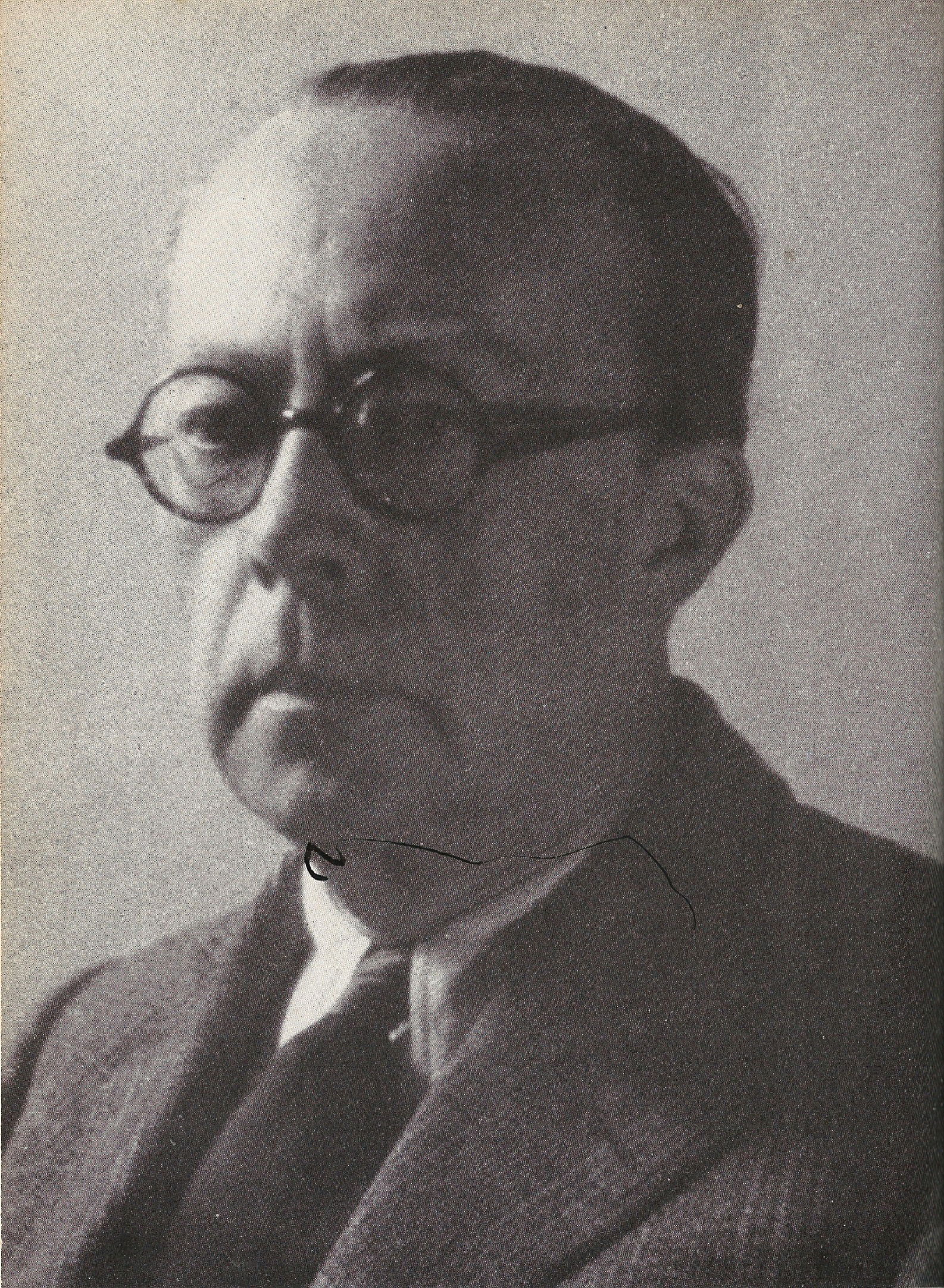
Prince Waldemar Hohenloe-Öhringen, Kommandant of Blechammer POW Camp
The Kommandant of Blechhammer POW camp, Prince Waldemar Zu Hohenlohe-Öhringen, related to the British Royal family through HRH Prince Philip, the Duke of Edinburgh, was accused of being too lenient with his prisoners. He was posted to Italy where he was captured by the British. After the war he kept in contact with John Brown and other POW’s by letter and was invited to reunions in England. He died in 1965 aged 74.
Fresh Start
On 25 September 1945 John Brown was deservedly awarded the Distinguished Conduct Medal (second only to the Victoria Cross for gallantry), in recognition of his exploits and bravery during the war, receiving his award from King George VI at Buckingham Palace. After his demob he returned his old job at Trumans Brewery. He later became a businessman in Newcastle before moving to Dorset where he became landlord of the Victoria Hotel, in Cranborne, Dorset. He died there in September 1965 at the age of 56.
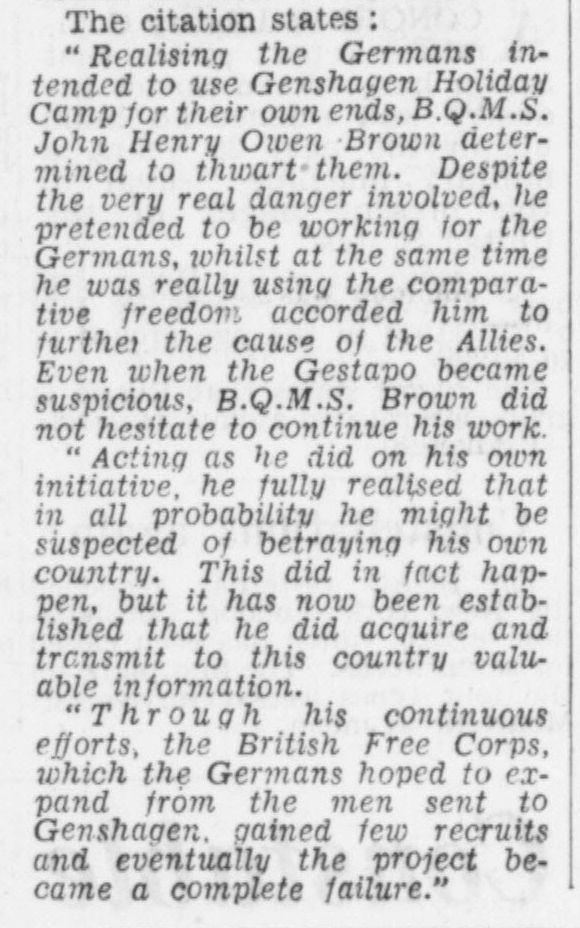
Citation that led to the award of the Distinguished Conduct Medal to B.Q.M.S Brown
There was to be no medal for Margery though. Her case was a lot more complicated as her reputation had preceded her. She had married a German, lived in Germany for a long time before and during the war and had taken up German citizenship. It was well known that she had met Hitler and the top Nazis, and that the Fuhrer was an admirer of her talents.
Some feel though that she was badly let down by the British Government who failed to give her the recognition she deserved. All she got in thanks was the return of her British Nationality, this was part in thanks to John Brown who personally submitted a statement in support of her, to the Government.
After the treason trials Margery returned to Southport with Mary Edwards to live with her in Sussex Road. Here she was able to convalesce and regain her health after her ordeal in Germany. As she struggled to adapt to a normal life this arrangement proved to be unsatisfactory. Despite owning the two properties her mother had bequeathed her she had no wish to evict the tenants and decided to move into a flat at 17 Manchester Road on the junction with Houghton Street, a few hundred yards from the town’s Marine Lake.
Another close friend, Dorothy Martland whose husband was a successful dental surgeon, ran the nearby Gables Hotel at 75/77 Hoghton Street. She invited Margery to move in as a guest. Dorothy's daughter Yvonne remembers that it was a happy time for Margery who made frequent trips to Wigan where she enjoyed shopping and visits to her favourite cafe, Pooles in Wallgate for lunch.
Some written accounts state that Margery was shunned by family and friends and the local community in Southport because of her war time connections to the Nazi hierarchy in Berlin but this not the case. Although she was an only child she had plenty of aunts, uncles and cousins, some of whom lived in Southport, and the publicity following the treason trials exonerated her of any fraternization with the enemy.
An article in the Evening Express in August 1946 told how Margery had received scores of letters from around the country, mainly from ex-POW's who had heard her sing at Genshagen. She said that she hoped to sing again for them when she had recovered her strength.
The Formby Times describes Margery making her first post war appearance three months later on 17 November 1946 in a concert in aid of seamen's charities at the Hippodrome in Southport. 1946. It had taken the British government two years but an entry in the London Gazette dated 22 August 1947 confirms that Margery had been readmitted as a British subject as from 30 June of that year.
Post war she spent her her time commuting between Southport. London and New York. Eventually she made the decision to emigrate to America in order to resurrect her singing career and is reported to have signed a contract worth £156,000 over two years to sing in North and South America.
Eugene Kallus
During her time in Bavaria after escaping from Berlin she met and struck up a relationship with a Jewish American Army Sergeant by the name of Eugene Ladislav Kallus. An advocate lawyer by occupation, He was born 18 December 1905 in Rosvegovo in Czechoslovakia, and was an advocate lawyer by occupation .
The day after German troops marched into Prague, Hungarian forces occupied and annexed the Podkarpatska region of eastern Czechoslovakia where Eugene was living in the small town of Tacovo, near the Romanian border, (now in the Ukraine and known as Tyachiv).
Eugene’s country had now ceased to exist, wisely he decided to emigrate to America to join his uncle, Max Bergman and Aunt Sarah in Brooklyn. He arrived in New York from Hamburg aboard SS New York on 8 May 1939.
Eugene enlisted in the US Army on 2 October 1942 at Fort Jay, Governors Island, New York. And issued the service number of 32518668. On 7 May 1943, exactly four years after entering the USA he was granted naturalisation as a US citizen whilst serving as a Corporal with Battery A, 197th Field Artillery Battalion at Camp Blanding, Jacksonville, Florida.
Shortly after, the unit was disbanded and the men dispersed to new regiments. His movements are not known but at some point he met and struck up a friendship with Margery at Naila in Bavaria. Eugene was discharged from the army on 19 Oct 1945. He sailed home to New York from the French Port of Le Havre on 9 December aboard the troopship USS Gustavus Victory.
Nearly a year later Eugene made a visit to England, arriving in London on 13 September 1946 aboard the USS Ferdinando Gorges. His destination address as shown on the shop's manifest was Margery’s home at Manchester Road in Southport.
However for Margery and Eugene their friendship wasn't yet to become a long term romance. On 29 April the following year, Eugene married a Czech lady by the name of Rose Havas in Prague. Rose was a widow with an 18 year old son, they were both Holocaust survivors. Rose was born in 1904 in Kajdano, Hungary (now in the Ukraine and known as Kajdanovo).
On 18 May 1944, the day that the Germans arrived in their home town to transport the Jews to the Auschwitz Extermination Camp, her father David Moskovics died of a heart attack as he was being arrested. Her mother Fani died in Auschwitz shortly after arriving.
As Prisoner No. 51007 Rose was transferred from Auschwitz to Buchenwald Concentration Camp on 4 October 1944, then moved to a sub camp to be used as slave labour. She was then transferred to Bergen-Belsen Concentration Camp in March 1945 where she was liberated by British troops a month later.
Her husband Dr. Leo Havas died in Auschwitz 10 October 1944 during a Sonderkommando uprising. After learning they were going to be killed the next day, workers at Crematorium No.4 attacked their SS guards. Some Germans were killed but over 250 prisoners died in the fighting and a further 200 were executed after the rebellion was suppressed.
Her sons, Robert and George were transferred from Auschwitz on 26 May 1944 to Mauthausen Concentration Camp in Austria. Robert died there aged eleven on 2 December 1944. George was liberated, aged 16 when the US 80th Infantry Division overran Ebensee, a sub-camp of Mauthausen on 6 May 1945.
In hindsight it looks as though it was probably an arranged marriage of convenience between Eugene and Rose in order to give her and her son the chance of a new life in America. On 27 March 1948, Rose petitioned for divorce from Eugene in Garland, Arkansas on the grounds of indignities (an American term for irreconcilable differences). At the time Eugene was in England with Margery, four days later on the 31st he departed London to New York on BOAC Flight No.1/27 to return to his residence at 260 West 78th St, in Manhattan.
Exactly a month later on 27 April, after a year of marriage the Decree Absolute was granted. Rose Kallus, who became an American citizen on 3 April 1951, died on 11 March 2005 in Babylon, Suffolk County, New York aged 100.
In November 1947 Margery sailed from Southampton on the Queen Mary, arriving in New York on 25 November. The ship’s manifest shows that her last address was an upmarket residence at 63 Princes Square, Notting Hill, in London. She is described as being a single woman, five feet ten inches tall, with auburn hair and blue eyes.
Margery’s contact in America, described as a friend, was Eugene’s sister Gizela Kallus Edlis. Known as Gizi, she was born in 1897, at the age of 24 she married Heinrich Edlis in her home town of Rosvegovo before settling in the Austrian capital of Vienna.
The couple lived in Schonbrunner Strasse in the south western suburbs of the city where they had three children, Klothilde born in 1922, Stefan Theodore in 1925 and Herbert Ernst in 1927. Heinrich died after a short illness in Vienna on 18 April 1938 aged 44, a month after the Austrian Anschluss.
The campaign against the Austrian Jews had begun immediately, with the Nazis dissolving Jewish organisations, institutions and schools, hoping to force Jews to emigrate. Their plans succeeded, by October 1941, when Jews were eventually banned from immigrating by Himmler, 130,000 Jews had already left Vienna, 30,000 of whom went to the United States.
Gizela and her three children were among the ones who emigrated to America. They left behind all of their property, but were forced to pay the Reich Flight Tax, a tax on all émigrés from Nazi Germany. This was set at 96% and was just a form of legalised theft to confiscate Jewish assets. With the help of her late husband’s cousin, Jerome Edlis, a businessman from Pittsburgh, Pennsylvania and the Jewish Transmigration Bureau they escaped Vienna in March 1941.
The family sailed from Lisbon in Portugal a month later aboard the SS Nyassa. Gizela had $50 to her name when they arrived in New York on the 25 April. Stefan later recalled that his uncle Eugene was waiting on the Pier with sandwiches for them. Austria’s loss was to become America’s gain, as all of Gizela's children were to become highly successful in their chosen careers.
Klothilde, known as Lotte, became a noted scholar, publishing four books and numerous scholarly papers. She studied at Stanford University in California and at Oxford University where she became a Doctor of Philosophy. In 1959 she married radio engineer Hans Motz, also born in Vienna but now a British subject. He was to become the first Professor of Engineering at Oxford University. Lotte died in Oxford in 1997, aged 75.
Two years after arriving in New York Stefan was drafted into the US Navy, serving on the island of Iwo Jima for six months where he spent the time looking for and burying the bodies of Japanese soldiers. After the war, he stayed on the West Coast in San Francisco, which had a bustling plastics industry and by 1965 he had founded the Apollo Plastics Corporation in Chicago, which made him a fortune.
He ploughed his money into collecting pop art worth millions of dollars. He and his wife Gael Neeson became well known philanthropists, donating works of art to Chicago’s Art Institute worth nearly half a billion dollars. Stefan died in Chicago in 2019, aged 94.
The youngest of the siblings, Herbert, graduated from Queens College and later the Albert Einstein School of Medicine at the Yeshuva University. Specialising in Oncology and Haematology, he worked at the Veteran’s Administration Hospital in the Bronx, New York for 45 years. Herbert passed away in October 2020 aged 82.
Margery made two more trips to New York, firstly departing Liverpool on 11 Aug 1949 on SS Britannic. She then made her final voyage on 31 March 1951, again from Liverpool aboard SS Franconia.
The ship’s manifest notes her occupation as singer and that she was travelling with twelve pieces of luggage. Her last address was the Gables Hotel in Southport, the home of her close friend Dorothy Martland.
Margery’s destination address in America was the home of Gizi Edlis, Eugene's sister, at 3819-52nd St, Long Island City, a seven bedroom property in the leafy suburb of Woodside. However fate intervened and her plans for a new life in America were to be cruelly cut short.
Margery died of cancer, in the Montefiore Hospital in the Bronx, New York on 11 April 1952, aged 46. The hospital records show her death recorded twice, one entry as Margery Booth, the other as Margery Kallus, but both with the same reference number.
On 29 April 1969, sixteen years after her untimely death, Margery’s cremated remains were interred under the name of Margery Booth Kallus, in Unit 8 of the Ferncliff Mausoleum at Ferncliff Cemetery in Hartsdale, New York State.
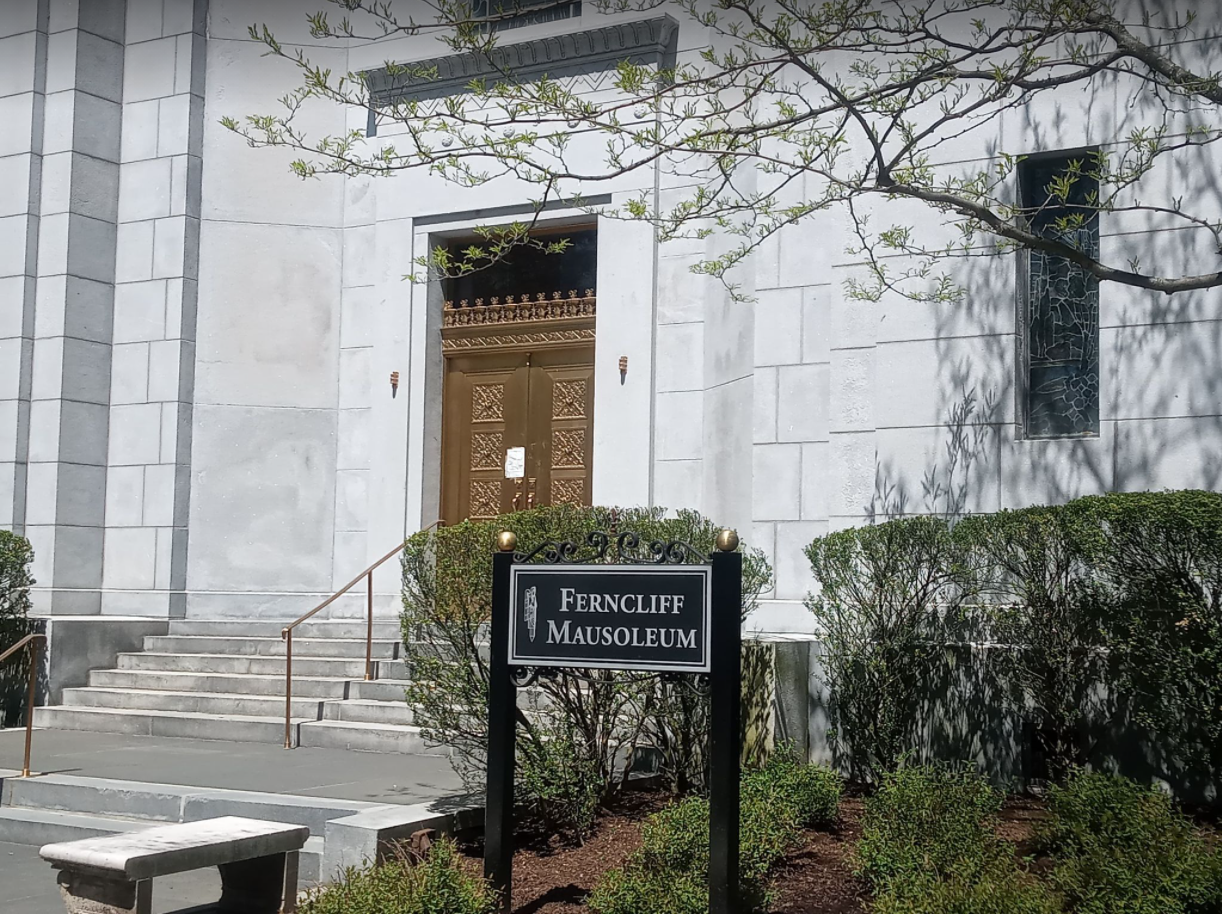
Margery's last resting place, Ferncliff Mausoleum, Hartsdale, New York

The niche at Ferncliff Mausoleum in Hartsdale NY, containing Margery's ashes
Eugene Kallus died on 30 July 1991 aged 85 at Sunnyside, Staten Island, he was buried in Maple Grove Cemetery, Kew Gardens, in Queens County, New York.

The grave of Eugene Kallus in Maple Grove Cemetery, New York
Margery Myers Booth, the girl from Wigan, who had rubbed shoulders with the rich and famous and some of the most notorious characters of the 20th century is one of the forgotten heroines of the Second World War. She slipped into history in 1952, without recognition, and with her story untold.
Postscript
To this day Margery Booth remains an enigma. Over the years since her death the myths surrounding her have grown and many unproven facts about her have been written. Nothing has been found so far in the MI5/MI9 files held at the National Archives to point to her being recruited before the war as an intelligence agent. It is more probable she helped Brown in his spying activities out of loyalty to her country. Surely if she were a spy her achievements would have been recognised and rewarded with a decoration like Brown.
It is said that she hid escaped prisoners of war in her flat, and was once escorting five evaders when they were nearly caught out in a air raid shelter during a German spot check. At present there is no documentary evidence to substantiate these claims. She did though hide a Jewess in her flat, as was confirmed in a letter that her friend Mary Edwards wrote to MI5 and is in the National Archives.
Some also claim that she was shunned by family, friends and the community in Southport on her return, because of her links to Hitler and his top Nazi officials. This was not the case as she was exonerated by the publicity after the treason trials, receiving letters from around the country, especially from ex-POW's .
In 2011 interest in Margery was aroused with the sale by auction of John Brown’s medals and war time memorabilia. These included photographs of Genshagen POW camp, amongst them some of Margery, letters from Prince Zu Lohenlohe-Ohringen, the Kommandant of Blechhammer POW Camp and a copy of Brown’s statement to the government urging them to reinstate Margery’s British citizenship.
Inspired by John Brown’s book and intrigued by her involvement, British born writer Prince Frederick von Saxe-Lauenberg persuaded his friend, actor and screenwriter Ralph Harvey (real name Count Sir Ralph de Straet Von Kollman) to write a screenplay for a film of Margery’s life. It was to be called ‘The Knicker Spy’.
In December 2011 the Wigan Observer newspaper ran an article on the subject indicating that filming would be starting the following year and would be premiered in 2013, but the film never materialised. In 2016 the idea was resurrected, Ralph Harvey, who was involved in the research and screenplay for the first film attempt in 2012, wrote a second screenplay entitled ‘The Spy in the Eagles Nest’.
It was published as a 117 page paperback on 8 October 2017 and is also available on Kindle. Reading the synopsis of the film shows that Ralph used artistic licence to good effect, mixing fact with fiction. Inevitably Margery is portrayed as the poor little mill worker from the back streets of Wigan, whose father dies and her mother is forced to take in a lodger to help pay the bills, which of course couldn’t be further from the truth.
To be produced by an independent company, Imperial Film Productions, the film went into pre-production in 2017. Anna Friel was cast to play Margery with opera singer Leslie Garret providing the operatic voice overs, other well-known names in the cast were Stephen Fry as Reich Marshal Herman Goering and Susan George as Margery’s mother, Florence. Ralph Harvey died in 2017 before the project on Margery could be completed and again the film was never released.
On 9 January 2017 Akushi Promotions announced that a short 15 minute documentary was to be made on Margery’s life. They released a 1 minute 5 second trailer video on YouTube entitled 'Margery Booth-The Forgotten Poppy'. Later in the same year they announced that research was ongoing for a longer documentary and released a 2 minute 53 second trailer entitled ‘Margery Booth-The Spy who Sang For Hitler’ but to date both documentaries have not yet been released.
However the project wasn’t entirely abandoned, still with the same title ‘The Spy in the Eagles Nest’ and original cast, executive director and screenwriter Franz von Habsburg-Toskana (who writes under the pseudonyms of Frank Tuscany) and Mark Denton wrote written another script. In the hope of luring a big name American actor to play in the film, Brad Pitt was sent the script.
On 9 August 1990 the Guardian newspaper reported that the then Mayor of Wigan, Councillor Ronald McAllister J.P had written to the Government Cabinet Office nominating Margery for a posthumous award such as the George Cross or George Medal. His efforts proved to be unsuccessful. The UK honours system is complicated with strict rules and criteria. There is a limit on the number of recipients of an award or honour that can be made annually and some honours cannot be awarded posthumously or made to foreign nationals.
Margery’s case is further complicated by the fact that she was a German Citizen at the time of her exploits during the war. After further enquiries the Honours Secretariat in the Cabinet Office clarified the situation. Margery fills the criteria for the award of the George Medal apart from one important point. Unfortunately all posthumous nominations have to be made within five years of the recipients death. This rule is strictly adhered to, without exception, so any attempt at a second nomination is doomed to failure and Margery will not be honoured by her country.
In January 2021, Tommie Harte, a young student at Myerscough College who founded the 'Notre Society' started a campaign to have Margery recognised in some form by her home town. He approached Wigan Council’s Blue Plaque Committee who accepted his nomination. On 22 December 2021 a blue plaque was unveiled in the foyer of the Queens Hall in Market Street, Wigan.

Graham Taylor
© 2021 Revised 2025 Graham Taylor - Copyright All Rights Reserved
Acknowledgements
Thanks to Rita Fell (Wigan Local History & Heritage Society) for Southport research. Elizabeth Taylor (New Zealand) for German research and document translations. David Cunliffe (New York) for photographs.
Special thanks to Gwynn Owen (Southport) for additional research for the 2025 revised version.
Bibliography
Beatty, Trevor, The POW Diary of Reg Beattie-Captive Plans, (LMNOP Books 2011)
Brown, John, In Indurance Vile (Robert Hale 1981)
Monteath Peter, POW 'Holiday Camps' in the Third Reich (European History Quarterly 2014)
Strohm Egon, Schmerzvolle Reise (Deutsche Verlags-Anstalt, Stuttgart 1946)
Verkaik, Robert, The Traitor of Colditz (Welbeck 2023)
References
Keleny, Anne. Geoffrey Perry: The Soldier Who Captured Lord Haw Haw, Independent (17 October 2014)
Landwehr. Richard. Britisches Frei Korps: British Volunteers of the Waffen-SS 1943-1945, Vermomt: Merriam Press, (2012)
The National WWII Museum, New Orleans, The Capture and Execution of William Joyce (1 January 2021)
Weale, Hadrian. British Free Corps in SS - Waffen, AustraliaRussia.com (retrieved 18 May 2016)
West, Rebecca, The Crown Versus William Joyce. The New Yorker (1945)
Wistrich, Robert, Who's Who in Nazi Germany, Routledge (4 July 2013)
Other Sources
49 Sqn RAF Association
Ancestry, England & Wales Birth, Marriage & Death Indexes (1837-2007)
Ancestry 1939 England & Wales Register
Ancestry UK Census Collection (1841-1911)
Ancestry UK & Ireland Outward Passenger Lists (1890-1960)
Ancestry US Arriving Passenger & Crew Lists (1820-1957)
Ancestry USA 1940 Census
Ancestry US Death Index (1949-1965)
Ancestry US Jewish Transmigration Bureau Deposit Cards (1939-1954)
Axis History Forum
Berlin Germany Marriages (1874-1936)
Brown, J. H.O, National Archives Ref: WO373/98/57
Calthrop, J. B.S, National Archives Ref: KV2/439
England & Wales National Probate Calendar (Index of Wills & Administrations) (1858-1995)
Find My Past
British Newspaper Archives
German Phone Directories (1915-1981)
Germany & Surrounding Areas, Address Books (1815-1974)
Imperial War Museum
JewishGen Online World Wide Burial Registry
Jewish Holocaust 1945 Register of Survivors
Lancashire Births Deaths & Marriages
Lancashire Online Parish Clerks
London Gazette
Pegasus Archive
Newspapers .com
The Independent 17 Oct 2014, Anne Keleny
UK City & County Directories (1766-1946)
Wigan Archives Online
Wigan World Burial Records
Wikipedia
Comments from original 2021 version
Michael 14/02/2025 09:08
Margery’s step mother, Ada, was my great aunt
stephen edmund hansen phillips 25/01/2025 07:31 PM
great article a gem
Glen 14/07/2024 10:20 AM
Fascinating article
Christine Barbour-Moore 27/08/2022 09:38 AM
Wonderful article. Her father Levi Booth lived as a boy at my old home Sicklefield House
Example Text
Example Text
Example Text